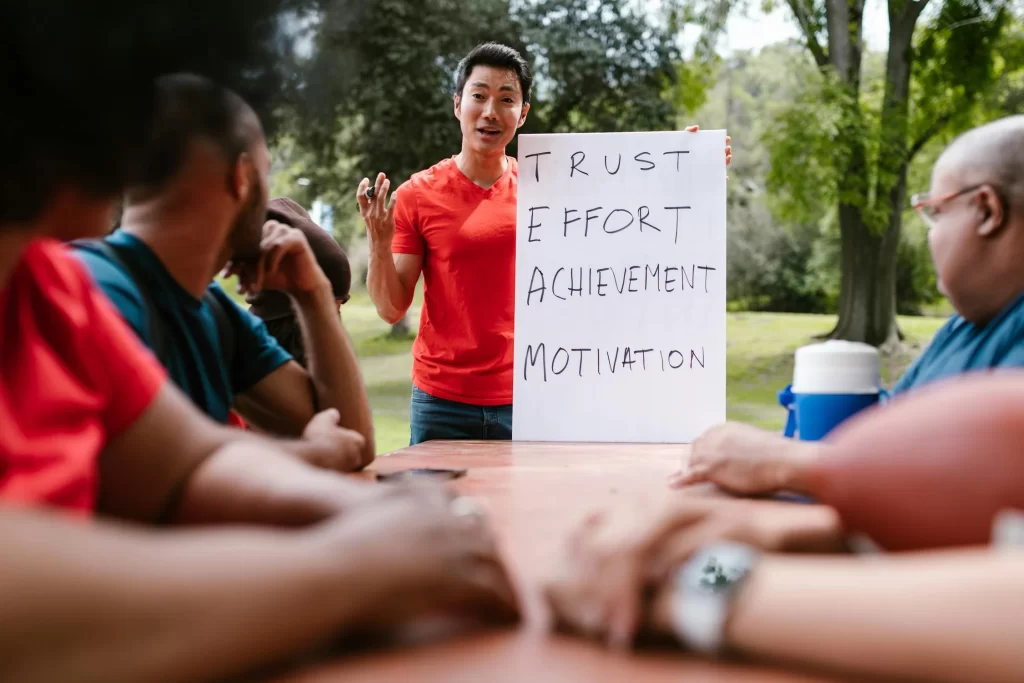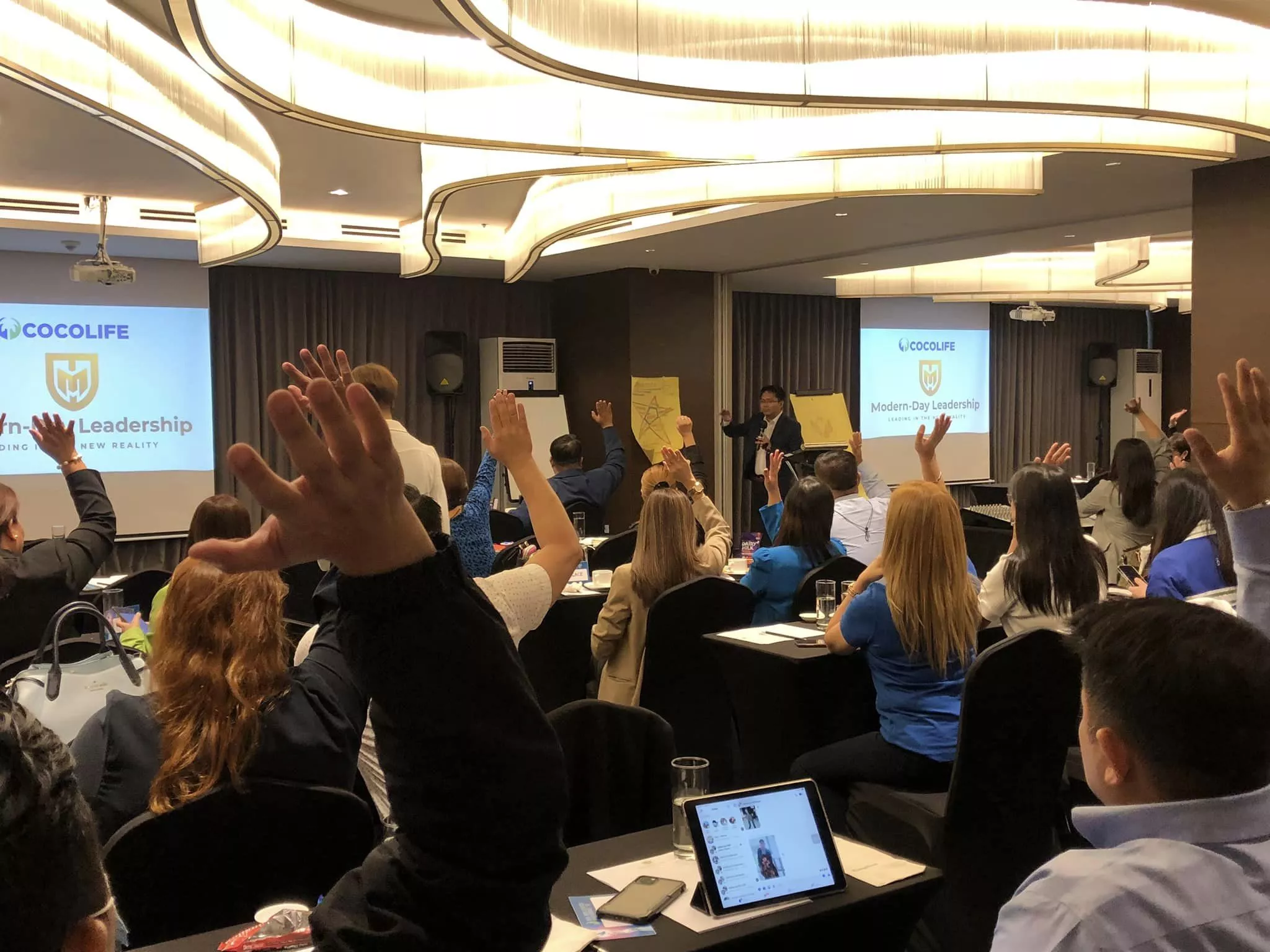Learning And Development Interventions in the Philippines
Learning and development interventions in the Philippines (L&D) refers to the structured programs and activities designed to enhance employees' skills, knowledge, and competencies within organizations.
These interventions are essential in addressing the specific needs and challenges of the workforce as well as the organizational objectives, creating and developing a culture of continuous learning and adaptation in a rapidly changing business environment.
Top Learning And Development Interventions in the Philippines
This list covers the top learning and development interventions in the Philippines and has been constantly updated to fit into the current learning needs of employees today. Here’s an overview of the top L&D interventions:
In-House Training Programs
Many Philippine organizations design in-house training sessions specifically tailored to their operational needs. These may include technical skills development like sales training and skills enhancement like leadership training.
Most L&D practitioners categorize in-house training programs into hard skills and soft skills - but today, they now call soft skills “core skills.”
Hard skills are technical skills that address the competencies of individuals for a specific task or job. For example, sales training programs are designed to elevate the closing rates and prospecting efficiency of salespeople within the organization. It addresses the performance gap between their current sales quota and their desired performance.
Soft skills, often called core or interpersonal skills, are non-technical abilities related to working and interacting with others. Unlike hard skills, which are about a person's skill set and ability to perform specific tasks, soft skills are more about behavior and thinking, personal traits, and cognitive skills. They are crucial for building relationships, gaining visibility, and creating more opportunities for advancement.
Online Learning and Blended Learning Platforms
With the digital transformation in the Philippines, many companies have adopted online and hybrid learning to provide their employees access to a wide range of courses and training materials.
This type of learning intervention enables flexible learning schedules and a broader array of topics.
Blended learning is an educated approach that combines traditional face-to-face classroom instruction with online learning and independent study. Participants can learn at their own pace and time while still experiencing a high-quality learning environment.
Mentorship Programs
Some organizations in the Philippines implement mentorship programs where experienced consultants, trainers, and professionals guide their less experienced employees.
Mentorship programs are typically one-way communication, where they help employees develop their skills and better understand the organizational mission, vision, and culture.
Most companies we’ve trainers in my corporate training company have created specialty mentorship programs for their managers and leaders - as these have a higher need for mentorship (e.g., thinking styles and skills).
Continuous Leadership Development Programs
As I’ve observed with Filipino companies as a trainer-consultant, some multinational companies create in-house leadership development programs to address continuous succession planning of leaders, new and transitioning managers, and supervisors and develop their existing managers.
Continuous leadership development programs start by identifying their leadership and development strategy, which include the following:
- Vision of the organization they support (it must support the company's overall vision in the current year).
- Leadership competencies (specific areas of leadership and management they want to highlight in their programs).
- Success measures (identified KRAs - Key Responsibility Areas and KPIs - Key Performance Indicators).
- Learning Journey (types of learning, and if it includes pre-training and post-training)
- Specifics of leadership development program (training schedule, objectives for each program, etc..).
In the Philippine context, leadership development programs are now an integral learning and development intervention and not just part of a soft skills training program.
Team Development
Often known as team building, team development is a learning and development intervention designed to address the pressing need for bridging alignment within an organization. Some are helping organizations to be more effective through interpersonal processes.
Team development (“team building”) can be categorized into three facets:
- Team alignment - for established teams but lacking understanding and applying culture alignment (as well as goal alignment) within each other. It aligns (as it calls it) teams within organizations to a common purpose, vision, or goals.
- Team bonding enhances professional relationships among participants to minimize or avoid conflicts and allow for better harmony and dynamics among teams.
- Team building helps unite employees within teams and creates a better work culture, which can lead to progress in performance and culture alignment.
Executive Coaching
Executive coaching is a learning and development intervention for senior leaders and the C-Suite of the organizations. It addresses their day-to-day challenges as they lead the entire organization.
Given their strict, busy schedules, executive coaching allows senior leaders and executives flexibility. It is an ongoing program to help unlock the potential of these high-level professionals to elevate their work performance and move the organization forward.
On-the-Job Training
On-the-job training is a practical approach to learning where employees learn by doing. They work on actual tasks under the supervision of a mentor or a supervisor, which helps them acquire job-specific skills and knowledge.
Observation is integral to this learning intervention as the observer (manager/supervisor) assesses the employee’s current job knowledge, skills, and attitude toward the given task/job.
Succession Planning
Succession planning involves preparing employees to take on critical roles within the organization in the future. It included a combination of training, shadowing, and mentoring - and, to some extent, a development program to allow the organization to create a pipeline of capable leaders.
Cultural Sensitivity Training
Given the Philipines' diverse culture andthe many organizations now working with professionals outside the country, some organizations provide training to help their employees understand and respect different cultural backgrounds, enhance teamwork, and reduce workplace conflicts.
In today’s learning and development, we call it “cultural intelligence” - connecting and adjusting to other people’s cultures to promote unity and achieve organizational goals.
These learning interventions areal for individual employees' growth andgnificantly to organizational success by aligning employee skills with the company’s strategic goals.
Leadership Training Programs in the Philippines
Leadership training programs are essential in driving business performance and sustaining growth.
Here is our curated list of leadership training programs for employees in the Philippines. We categorize it based on levels and development so you can see what fits your current learning and development or training plan.
Leadership Training Programs (By Level)
Leadership Training for Transitioning Managers
- Fundamentals of Leadership - This training program helps your transitioning leaders understand the different leadership styles, the role of a manager, and tips and strategies in transitioning from peer to manager job. Invest in our leadership training.
- People Management: It focuses on motivating teams, delegation, performance management, and giving effective feedback. These are the essential skills of a manager.
- Communication Skills: This training program is designed to help participants develop effective communication strategies, active listening, and conflict resolution. See our communication skills training.
- Change Management: A modern-day leadership training program focused on teaching strategies for managing change within a team, adapting to the ever-changing work environment and industry, managing effectiveness in transitioning to new roles, and guiding teams through transitions. Develop your people with change management training.
Leadership Training for Managers and Supervisors
- Strategic Thinking: The program speaks on developing and implementing strategic plans based on organizational and department goals, with strategies for decision-making processes and innovation management. See our strategic thinking training.
- Advanced People Management: This program leans toward cultivating high-performance teams, advanced conflict resolution, and managing diverse teams. Invest in leadership and management training.
- Leadership Ethics: A rarely discussed training program, but it is vital in today’s rapidly changing world. This leadership program focuses on understanding ethical leadership, corporate social responsibility, and creating an ethical workplace culture within your teams.
- Coaching and Development: This is an introductory course to develop skills in coaching for performance and succession planning (for multiple leadership roles in the company).
Leadership Training for Senior Leaders and Executives
- Visionary Leadership: A leadership training program to help senior leaders develop a compelling vision, strategic alignment, and execution through the vision - all these are vital in directing an organization to the next level of growth.
- Influence and Negotiation: A technical-based leadership program teaches leaders and executives about influencing others, negotiation skills, and stakeholder management.
- Executive Decision Making: The majority of executives' work deals with decision-making. Having a suitable framework or set of values to consider can help increase the likelihood of making significant decisions for the company - this now involves risk management and critical thinking at the executive level. See our executive leadership training.
- Leading Organizational Change: A leadership training program in executing strategies for leading large-scale change, transformational leadership, and change resilience.
Leadership Training Programs (By Development)
Personal Leadership
This level of development for leadership training programs focuses on self-awareness and self-management as the foundation of effective leadership. Personal leadership should be considered a core skill (not just a “soft skill”) nowadays. Participants will learn to understand their leadership styles, values, and strengths and how all these can influence their interactions and decision-making for their teams.
Here are some of the top training programs for personal leadership.
- Strategic Thinking: This training helps leaders develop the ability to think strategically, adapt to changes, anticipate future consequences and trends, and consider the broader impact of their decisions. It involves understanding the organization's vision, setting long-term goals, and developing plans to achieve them. Learn more about our strategic thinking training.
- Critical and Creative Thinking: This leadership training program helps participants enhance leaders' ability to analyze complex problems, generate new solutions, and make decisions under uncertainty. It may involve learning different creative thinking and problem-solving frameworks, logical reasoning, and innovative thinking to address challenges creatively and effectively.
- Leadership Essentials: A foundational personal leadership program that covers the critical aspects of effective leadership, including business ethics, discipline, setting direction, inspiring others, driving change, and delivering results. It's designed for new or aspiring leaders to build core leadership skills.
Leading Others
This developmental leadership training course focuses on interpersonal aspects of leadership, such as inspiring teams, influencing and leading even without authority, and building productive relationships. It's about guiding others toward shared goals while fostering organizational collaboration and commitment.
- Coaching and Mentoring: In this Leading Others program, participants should learn how to develop others through coaching and mentoring, which provide guidance, feedback, and support to help individuals grow their skills, improve performance, and achieve their career objectives. It may consist of coaching frameworks that leaders can use to coach their direct reports. Learn about coaching and mentoring training.
- Introduction to Performance Management: This leadership training program introduces leaders to the principles and practices of effective performance management, including setting clear expectations, monitoring performance, and conducting performance evaluations. The corporate trainer may include frameworks they use to help other companies, or they can integrate an in-house (what has been used) by their target client and enhance it during the training. Invest in performance management training.
- People Handling Skills: This training helps leaders learn more about techniques to manage diverse personalities, resolve conflicts, and handle difficult conversations. This training is essential for building a harmonious and productive workplace. See our people handling skills training.
- Feedback Giving: This leads the other programs to focus on the art and science of providing constructive feedback to encourage development and improve performance. Leaders learn how to deliver feedback in a clear, specific, actionable, and sustainable way.
- Team Performance 101: This training covers the fundamentals of building and leading high-performing teams, including team dynamics, collaboration, and leveraging the strengths of team members to achieve common goals. Different frameworks, such as those by Dr. John Maxwell, a leadership guru on teamwork 101, can help trainers develop a solid team performance course. Build your teams with our high performing team training.
- Inclusive Leadership: This leadership training program addresses the importance of diversity and inclusion in the workplace (we call it a DIBER training program (Diversity, Equity, Inclusion, and Belonging). Leaders will understand and apply strategies to create an inclusive environment where all team members feel valued and can contribute to their fullest potential. See our inclusive leadership training.
- Situational Leadership: This approach teaches leaders to adapt their style based on the situation and the needs of their team members. It emphasizes flexibility and the ability to diagnose the circumstances and respond with the most appropriate leadership behavior. With frameworks from Ken Blanchard (4 situation leadership styles framework) or Dan Goleman (on emotional intelligence), you can develop a training program to help your leaders identify their situational leadership styles and apply them to their workforce. Invest in our situational leadership training.
Rainmakers As A Leadership Training Provider
We’ve covered enough of a list of training programs for different employee levels and development. You can check out our full list of training programs for employees in the Philippines.
If you need a leadership training provider, send us your training requirements so we can schedule a training needs analysis session with your team.
Venchito Tampon, the founder and lead trainer of Rainmakers, has been speaking with and training thousands of leaders in the Philippines and Southeast Asian countries. We develop customized and personalized leadership training programs to suit the developmental needs of your employees.
List Of Training Programs For Employees In The Philippines
Building your employees’ competencies is an integral part of your organization's learning and development facet.
If you’re wondering what types of training programs are helpful in today’s day and age and help close the performance gaps. Here is our curated list of training programs for employees in the Philippines.
We categorized it based on ranks or levels, so you can easily see the difference for broad training programs (i.e., leadership training programs).
List of Training Programs (By Level)
Entry-Level and Rank-and-File:
- Customer Relationship Management: This training is designed to build and maintain positive relationships with customers, to know their deep desires and concerns, and to serve them to increase satisfaction and loyalty.
- Conflict Resolution: A training course on discovering techniques for resolving workplace conflicts and promoting a healthy collaborative environment.
- Digital Literacy: Training to develop skills in utilizing digital tools and platforms, essential in modern-day work environments.
- Success Training: A training to elevate self-inspiration and discipline to meet employees’ personal and professional goals, fostering a mindset geared towards individual and organizational success. See our success training.
- Productivity and Workload Management Training: Help your employees learn how to manage workload efficiently, prioritize tasks, and improve productivity. Invest in our productivity training.
- Mental Health: A training that brings awareness and strategies to maintain well-being, stress management, and foster a healthy work-life balance or harmony.
Mid-Level Management:
- Emotional Intelligence: A training to enhance the ability to perceive, use, and manage emotions positively to relieve stress, communicate effectively, and empathize with others (colleagues). Check out our emotional intelligence training.
- Problem Solving and Decision Making (PSDM): A training to develop critical thinking and problem-solving skills to make informed, wise, and effective decisions at work. See our PSDM training.
- Effective Business Communication: A training to enhance clear and compelling business communication, both internally and externally, that will help improve interpersonal and presentation skills. Know more about our business communication training.
- Basic Leadership Training: This is training to learn and acquire fundamental leadership skills, including how to motivate team members, make ethical decisions, and inspire trust among teams. See our basic leadership training.
- Leadership Mentoring and Coaching: A training for mentoring and coaching team members, fostering team development, and building leadership pipelines within the organization. Learn more about our coaching and mentoring training.
- Giving Feedback: A training to develop skills for providing constructive feedback to promote professional growth and performance improvement.
- Change Management: A training to prepare leaders to guide their teams through change, addressing resistance, and ensuring successful implementation of new initiatives.
- Strategic Thinking: A training to help cultivate the ability to think strategically, plan long-term, and anticipate future challenges and opportunities. See our strategic thinking training.
- Cross-Cultural Competence: A training to help employees understand and navigate cultural differences within the workplace to enhance communication and team cohesion in diverse environments. This is mainly done in training for global or multi-national companies.
Senior Management and Executives:
- Executive Presence: A training to help build the charisma, confidence, and clarity employees need to command respect and inspire confidence in others.
- Executive Leadership: A training to help leaders gain advanced leadership skills to drive the organization’s vision, make strategic decisions, and foster a robust organizational culture. Build skills with our executive leadership training.
- Business Strategy: A training course on developing and implementing robust strategies to guide the organization's direction and ensure its competitiveness in the market.
- Succession Planning: A training to prepare senior leaders for leadership transitions, ensuring the organization’s resilience and continuity by identifying and developing future leaders.
- Innovation Management: A training to foster an innovative culture, manage the creative process, and implement innovation strategies for growth and competitiveness. Invest in our innovation management training.
- Global Leadership: A training to help senior leaders lead across borders, understand global market dynamics, and manage across cultures.
List of Training Programs (By Skills Development)
Sales and Marketing Training:
- Fundamentals of Sales: A training course to help sales agents understand the value and foundational principles of selling, understand customers' needs, and develop compelling sales pitches. See our sales training.
- Advanced Sales Techniques: A training to enhance one’s negotiation skills, relationship building, and closing sales. This training leans towards the second half of the pipeline process (up to closing deals).
- Strategic Selling: A training to help salespeople develop strategies to tap different market segments and manage sales pipelines more effectively.
- Digital and Social Media Sales Strategies: A training to help sales teams utilize digital platforms to generate leads and close deals.
- Digital Marketing Skills: A training designed to help marketers and salespeople understand and apply strategies in SEO, PPC, social media marketing, content marketing, and email marketing to enhance their brand’s online presence and digital reach. Invest in our digital marketing training.
- Market Research and Analysis: This is training to develop skills in gathering, analyzing, and interpreting market data to make informed marketing decisions.
- Brand Management: A training to help marketers focus on building and maintaining a solid brand, understanding brand positioning, and managing brand equity.
- Customer Engagement and Relationship Management: A training to help front-liners learn and apply strategies to engage customers, improve customer experience, and build long-lasting relationships with stakeholders.
- Strategic Marketing Planning: A training to acquire skills in developing comprehensive marketing strategies that align with business objectives and adapt to changing market conditions.
Negotiation Training:
- Essential Negotiation Skills: A training to help employees in procurement and supply chain management understand the fundamentals of negotiation, including preparation, communication techniques, and closing agreements. See our negotiation skills training.
- Advanced Negotiation Techniques: A training on complex negotiation strategies, handling objections, and multi-party negotiations.
- Negotiating in High-Stakes Environments: A training designed to learn how to handle high-pressure negotiation scenarios and large-scale deals.
- Cross-Cultural Negotiation Skills: A training to help individuals adapt negotiation strategies to different cultural contexts and global environments.
Customer Service Training:
- Customer Service Essentials: A training to understand the core principles of customer service, including empathy, active listening, and problem resolution. Invest in our customer service training.
- Handling Difficult Customers: A training to cultivate and apply strategies for managing challenging interactions and turning negative experiences into positive outcomes. Best for customer service representatives or personnel.
- Enhancing Customer Experience: Training new and experienced customer service personnel (or frontline workers in the hotel and hospitality industry) to learn techniques to exceed customer expectations and foster loyalty.
- Customer Service in a Digital World: A training to help target participants adapt customer service practices for digital communication channels.
Communication Skills Training:
- Effective Interpersonal Communication: A training to help elevate verbal and non-verbal communication skills, enabling employees to express ideas clearly and foster better workplace relationships.
- Public Speaking and Presentation Skills: This training is designed to improve confidence and clarity in public speaking. It covers structuring content presentations, engaging the audience through proper delivery, crafting stories that resonate with them, and effectively conveying messages. Learn more about our public speaking training.
- Non-Verbal Communication Mastery: A training that teaches the interpretation and use of body language, facial expressions, and other non-verbal cues to enhance communication effectiveness.
Time Management Training:
- Prioritizing and Goal Setting: A training to introduce strategies and methods for setting achievable goals and prioritizing tasks to enhance efficiency and productivity. Participants can harness productivity and goal-setting skills during the training using the Eisenhower Framework or Michael Hyatt’s Free T of Focus. Invest in our goal setting and action planning training.
- Overcoming Procrastination: A training that offers strategies to identify and overcome procrastination habits, fostering a more proactive work approach.
- Time Management Tools and Techniques: A training introducing various tools and techniques to manage time effectively, enhancing personal and team productivity. In our productivity training, we introduce our Simplify Framework to teach our target principles with basic task management principles and strategies.
Problem-Solving Training:
- Creative Problem Solving: This training focuses on developing creative approaches to problem-solving and encouraging innovative thinking and solutions.
- Critical Thinking Skills: A training to enhance the ability to analyze information, identify biases, and make reasoned decisions.
- Decision Making Under Pressure: A training to help prepare individuals to make quick, effective decisions in high-pressure situations.
Project Management Training:
- Basics of Project Management: A training to help cover fundamental project management principles, methodologies, and tools.
- Agile and Scrum Methodologies: A training to introduce Agile and Scrum frameworks, focusing on flexibility and team collaboration.
- Risk Management in Projects: A training for methodologies to identify, assess, and manage risks in project settings.
Human Resources Skills Training:
- Recruitment and Selection Techniques: A training to help HR practitioners learn and apply effective strategies for attracting, selecting, and retaining the right talent.
- Employee Engagement Strategies: Training for HR and OD (Organizational Development) professionals on boosting employee engagement, satisfaction, and productivity.
- Diversity and Inclusion Training: This training focuses on creating an inclusive workplace, understanding diversity issues, and promoting equity.
- Training Needs Analysis - Training to teach trainers and OD professionals conduct training needs analysis as the initial phase in creating training programs for their employees. See our training needs analysis training.
- Train the Trainers - This training is specifically designed for employees conducting training programs, from training needs analysis to training evaluation. Invest in our train the trainers training.
If you’re looking for a partner learning and development outsourcing or training provider, contact us for a free quote or list of our training programs.
The Ultimate Guide to Conducting Training Needs Analysis
Training needs analysis (or TNA) is the process of identifying observed performance gaps between the current and desired knowledge, skills, abilities, and habits of employees.
Conducting training needs analysis allows you to create customized training design programs that get results for your beneficiaries.
At Rainmakers Training, we start by setting up meetings with prospective clients, asking questions about their training needs, and focusing on identifying their employees' performance gaps.
A need is a deficiency that prevents attaining goals or fulfilling a desired state or situation.
For employees in different organizations, some examples of training needs could be:
- Lack of knowledge of the latest product offerings.
- No facility is available to do one-on-one coaching or mentoring.
- Insufficient number of front-line employees to serve clients’ needs.
Analysis of the ADDIE Model
ADDIE model is a systematic instructional design framework that guides OD and training facilitators in creating educational and training programs.
ADDIE stands for Analysis, Design, Development, Implement, and Evaluation.
Training needs analysis corresponds to the Analysis phase of the ADDIE Model. It is the initial phase where the instructional designer (or training analysts) assesses the learners' needs, identifies the learning objectives, sets learning goals, and analyzes the learning context and constraints.
Mistakes of OD Professionals
Organizational development practitioners and training facilitators tend to make mistakes when conducting training needs analysis. Some mistakes I’ve observed that should be taken into consideration are:
Omitting the Training Needs Analysis (TNA)
If you’re not conducting TNA, you will likely create a training program design that won’t fully address any performance gap. Even so, it won’t directly address the needs of your training beneficiaries (or target participants).
TNA should be in every trainer’s DNA, as it assists them in designing a result-based learning program for their clients' organizations.
Implementing a learning intervention to a non-learning need.
It is best to identify a need if it is a learning need before applying a necessary intervention.
Many organizational development interventions, including strategic planning, organization redesign, quality management, and job design, aren’t learning-centric but could address a non-learning need.
Failing to evaluate the impact of the learning intervention.
When learning interventions are not evaluated regarding their impact on the client’s key result areas, stakeholders are less likely to buy in.
See to it you evaluate learning interventions, such as training programs, for their impact on the stakeholders weeks and months down the line.
Lacking continued implementation or reinforcement.
No follow-through means not having enough support to continue the specific learning intervention.
Invest in the sustainability of learning interventions to see their progress and impact on stakeholders, teams, and organizations.
Absence of endorsement or backing from senior management.
Without buy-in from senior or top management, there would be delays in the full implementation of the learning program.
Create reports and documents to supplement the importance and value of training design programs based on their impact on the business’s bottom line.
How to Conduct Training Needs Analysis
Conducting a training needs analysis requires a step-by-step approach to ensure data is gathered and all specific details needed for TNA are captured. Here is our step-by-step guide to applying a TNA to a client/organization.
Step 1: Determine Your Level of Analysis, Approach, and Objective of TNA (WHAT of TNA)
These three refer to the WHAT of training needs analysis.
Let’s start with the level of analysis.
Every training need is analyzed based on its target beneficiaries.
Levels of Analysis
There are three levels of analysis: organizational level, group or project level, and individual level. Here’s a quick run-through of their differences:
- Organizational level - you analyze the organization-wide goals, needs, and problems to see where training is needed.
- Group or project level: examines jobs or tasks performed by groups and the specific KSA (Knowledge, Skills, and Abilities) needed to attain organizational objectives.
- Individual level - analyze each employee's actual KSA and current performance to determine what specific training needs are required in which area/s.
When determining the level of analysis, see to it from the perspective of the opportunity and problem of the organization. At its current situation, what level of analysis will your TNA should target?
Approach or Technique
There are two classical approaches to use for TNA: opportunity- or growth-based and problem-based.
You use a problem-based approach when gaps in KSA (knowledge, skills, and abilities) need to be addressed.
For example, if your customer service rating is 3.5 when it should be 4.5 or 4.9, a gap of 0.5 should be addressed, possibly through training programs.
On the other hand, an opportunity—or growth-based approach deals with the next-level KSA benchmark of a specific employee, unit, or team.
The focus is on the opportunity or next-level growth of the individual (employee), unit, or team.
Let’s say you’re currently hitting your sales quota of 50 B2B accounts every month. The opportunity-based training is needed to help your sales team increase their performance by 30%.
Checking whether the training needs approach is problem-based or opportunity-based depends on the facts gathered and observation insights, as well as the ability of the HR or OD team to prioritize certain issues to achieve their performance objectives.
Some questions to consider when determining what training approach to prioritize:
- Is there a performance problem that needs to be addressed?
- What issues, needs, and problems arise from the data-gathering methods?
- What is the top management's current direction in addressing the situation of employees?
As OD practitioners, it is essential to identify the KSA employees' needs in order to do their work and meet their performance targets.
You can gather documents from your client/organization showing performance indicators and gaps. We asked for it at our corporate training company to ensure we see exactly any gap they face.
Objectives of the TNA
There are several objectives for doing a TNA. Some of the most important ones are:
- Identifying the KSA needed by a group to design a training program
- Assessing the individuals or groups on the level of their competence.
- Developing the required advancement for organization development (OD) initiatives
Determining the exact objectives of the TNA helps you focus the initiatives of your training interventions on these objectives and evaluate their progress accordingly.
Step 2: Identify Data Gathering Sources, Methods, Tools, and Data Analysis (HOW of TNA)
Your next step in conducting a TNA is examining available data-gathering sources, tools, and methodologies. This is the nitty-gritty part of training needs analysis, where you’ll dig deeper into your target beneficiaries' needs, challenges, and performance gaps.
There are several options for data gathering, but I’ve included here ones that OD practitioners popularly use:
1. TNA Meetings
Schedule a meeting with a client to discuss training needs for the program.
Some questions I often ask include:
- Why did you come up with the particular training program?
- Are there any challenges your target participants face in their daily work?
- Have you observed any issue, concern, or visible problem about this specific area of training need?
- When and where did the issue or problem first occur?
- What has been done to resolve the problem?
- Which other departments, units, or teams are being affected?
The first question often reveals the intention of the top management or in-house HR/OD practitioner in conducting training interventions. This is essential in helping you understand where they’re coming from (context) and how a particular training needs to connect to a desired objective or goal of the management/HR team.
2. Interviews
Interviews are often used with a small number of respondents and when difficult topics need to be discussed (e.g., healthcare, family welfare, mental health, and other issues that are difficult to interpret).
Always maintain a light, conversational tone when conducting interviews to allow respondents to open up about their concerns and challenges. Avoid asking too many questions at a time and ask questions that are easy to understand. Focus your agenda during the interview to maximize time.
3. Observation
The observation methodology of TNA is another level in which the OD/training facilitator directly goes to the client’s facility to observe the natural behavior of target participants.
This is a great way to acquire responses utterly free from bias, as you get direct answers from training beneficiaries.
The key to conducting a practical TNA observation is to observe individuals naturally (without people getting you noticed). Then, input insights relevant to the training needs/objectives you’re looking for into the observing sheets.
3. Focus Group Discussions (FGD)
Often known as FGD in the HR & OD practice, focus group discussions are primarily used to observe group dynamics in a short span.

By tackling difficult topics and getting opinions and data from a group, the training analyst/trainer becomes knowledgeable about the group's specific challenges, which makes them understand the nuances and context of the audience to which they’ll be conducting training.
When doing FGD, choose the groups wisely according to the demographics and objectives of your TNA.
Allow participants to answer questions without pressure and allot a significant amount of time to get answers from them.
5. Surveys/Questionnaire
Training analysts (or trainers) use surveys to collect both quantitative and qualitative data. They can quickly gather data from a large population to help them statistically understand context and performance needs.
Make statements/questions for surveys easy to understand so that various participants can interpret them similarly.
Ensure grammar and language are correct. Pertain to one point per question. Reread the questionnaire to check for consistency of message and flow.
6. Document Analysis/Review
A deeper level of TNA is conducting document analysis or review to get data from past activities of a specific group, unit, or individual. This allows you to create relevant questions for surveys or interviews.
Documents won’t answer questions, so be objective when handling document analysis. Although you may have little information, it allows you to be more investigative about the training needed for the performance of your target beneficiaries.
To capture more accurate responses from your participants, it is best to utilize other data-gathering tools, such as interviews or FGD.
How to Organize Insights From TNA Gathering Methods and Tools?
There are simple, practical ways that I’ve applied over the years to ensure insights and data gathered from various data-gathering tools on TNA will be used optimally when creating a training needs analysis plan. Here are some that you might find helpful:
- Prioritize data and insights that are most relevant to your TNA objectives. The key is to make the necessary information immediately visible for review.
- Run data and needs through a root cause analysis, including interviews and discussions with your HR or OD client, to deep-dive into TNA's primary objective.
- Write down a TNA plan to summarize all insights and data and present it neatly to your client for review.
Step 3: Clarify Project Management Details and Resource Requirements (WHEN and WHERE of TNA)
The next step is to include the requirements to facilitate the training needs analysis.
Identify the resources and support (unit, team, or individual) to conduct the TNA.
For example, if you’re doing focus group discussions (FGD), you may need support from the HR & OD team to contact a sample size of the beneficiaries for discussion interviews.
The resources and requirements depend on the data-gathering method you utilize for TNA.
Here are some samples of resource requirements you need to consider:
- Time and presence of respondents
- Venue for meetings
- Data gathering activities
- Office requirement
- Supplies
- Budget
Some training needs analysis activities (e.g., FGD, observation) may require longer preparation time, while others only require time to discuss details online (e.g., TNA meeting and interview).
Determine what you need to complete this TNA. Be more specific about the resources and requirements for planning and executing it.
Step 4: Highlight critical stakeholders (WHO of TNA)
As mentioned earlier, support from top management and key people in people development is essential for successfully conducting training needs analysis.
Determine the key stakeholders concerned or will be affected by TNA activity. See who gets to be involved in the process. The top management directly supports it, or its target beneficiaries are all company employees.
Specify the key stakeholders in your TNA plan.
KSA in Identifying The Performance Gap
Competence involves knowing the KSA framework, which stands for knowledge, skills, and attitude.
This is essential in identifying the performance gap as part of the training needs analysis phase.
When working with clients through different data-gathering methods, it is essential to determine specific knowledge, skills, and attitude gaps of target beneficiaries.
To give you quick samples of areas of KSA, here’s a run-through overview:
Attitudes
- Curiosity
- Desire to succeed
- Open-mindedness
- Resilience
Skills
- intellectual skills
- Social skills
- Communicative skills
- Physical skills
Knowledge
- Facts
- Figures
- Concepts
- Ideas
When I conduct training needs analysis with our clients at Rainmakers Training, I use this KSA framework to ask questions to determine the deep needs of the target participants.
This would allow us to develop a customized training program that closes the identified performance gaps regarding knowledge, skills, and attitude.
How to Write a Terminal Objective
Terminal objective refers to the overall goal or desired outcome that a training program aims to achieve by its conclusion.
It is usually a statement that consists of the critical knowledge, skills, and attitudes that participants should demonstrate upon completing the training.
Here’s an example of a terminal objective:
By the end of this training, the participants of the sales team will be able to identify customer needs accurately, develop tailored sales pitches, and employ effective closing techniques through the High Impact Sales Framework to enhance sales performance and customer satisfaction.
A terminal objective includes objectives, content, methodology, target participants, and training results.
In my example, the objectives are identifying customers’ needs, developing sales pitches, and employing effective closing techniques.
The methodology is the High Impact Sales Framework. The target participants are members of the sales team. The results could enhance sales performance and customer satisfaction.
Terminal objectives are essential elements in a training program design, as they dictate the focus of a training program. By defining terminal objectives, you’ll be able to see and evaluate the impact of your training program on target participants.
If you’re looking for a comprehensive program on train the trainers or a standalone program on conducting training needs analysis, schedule a call for a free strategy session.
Leadership and Employee Engagement: Strategies for Boosting Motivation and Productivity
Leadership and employee engagement is a management approach focused on cultivating a work environment where employees are emotionally invested in their work and committed to the goals and values of the organization.
It involves fostering open communication, providing support and resources, recognizing achievements, and empowering employees to contribute their best efforts.
Effective employee engagement leadership aims to create a positive workplace culture that encourages collaboration, innovation, and overall job satisfaction among team members.
How Leaders Impact Employee Engagement
Leaders play a pivotal role in shaping the dynamics of employee engagement within an organization. Their influence extends across various dimensions of the workplace environment, directly impacting employees' commitment, motivation, and overall job satisfaction.

Here's a detailed look at how leaders influence employee engagement:
Setting the Tone for Organizational Culture
- Role Modeling: Leaders exemplify the behaviors and attitudes they expect from their team members. By demonstrating commitment, integrity, and enthusiasm, leaders set a standard and create a culture that encourages engagement.
- Building Trust: Transparent and honest communication fosters an environment of trust. Leaders who are open about their decisions, acknowledge challenges and share successes make employees feel valued and integral to the organization.
Fostering a Sense of Belonging and Purpose
- Vision Communication: Leaders articulate a clear and compelling organizational vision. When employees understand how their roles contribute to broader organizational goals, they are more likely to be engaged and motivated.
- Inclusivity and Diversity: Promoting an inclusive workplace where diverse perspectives are valued enhances leadership and employee engagement. Leaders who recognize and celebrate diversity foster a sense of belonging among employees.
Enhancing Employee Growth and Development
- Professional Development: Leaders who invest in their employees' growth through training, mentorship, and career advancement opportunities show that they value their team's long-term success, boosting engagement.
- Feedback and Recognition: Constructive feedback and recognition of achievements affirm employees' efforts and talents, reinforcing their engagement and commitment to the organization.
Creating a Supportive and Collaborative Environment
- Empowerment: By delegating responsibility and offering autonomy, leaders empower employees, encouraging initiative and innovation and enhancing engagement.
- Team Dynamics: Leaders who nurture positive team dynamics and collaboration create an environment where employees feel supported and more engaged.
Ensuring Well-Being and Work-Life Balance
- Attending to Well-being: Leaders who prioritize the well-being of their employees through supportive policies and resources ensure that employees feel taken care of, fostering engagement.
- Promoting Work-Life Balance: Acknowledging the importance of balance and providing flexibility where possible helps employees manage their personal and professional lives, enhancing their engagement and loyalty.
Leveraging Effective Communication
- Active Listening: Leaders who actively listen to their employees' ideas, concerns, and feedback create a culture of respect and mutual engagement.
- Consistent Communication: Regular and clear communication about organizational changes, challenges, and successes keeps employees engaged.
Corporate Training and Employee Engagement
Corporate training enhances leadership and employee engagement by equipping team members with the skills and knowledge necessary to excel in their roles and contribute meaningfully to the organization's objectives.
Effective corporate training programs are about professional development and signaling the company's investment in its employees' growth and success.
Employees who receive relevant, high-quality training feel more competent and confident in their abilities, directly impacting their engagement and productivity. Training programs tailored to meet employees' specific needs and aspirations resonate more, showing them that the organization values their individual growth and career progression.
Corporate training fosters community and shared purpose among employees. Collaborative training sessions, workshops, and team-building activities enhance social connections and encourage teamwork, further boosting engagement. Organizations facilitate a learning culture by making employees feel part of a dynamic and evolving workplace.
Ongoing training opportunities allow employees to stay abreast of industry trends and innovations, which can invigorate their interest and enthusiasm for their work. When employees see a clear path for advancement and feel equipped to tackle new challenges, their commitment to the organization strengthens.
Corporate training is a pivotal engagement tool that enhances employees' skills and knowledge and demonstrates the organization's commitment to their development and well-being.
A well-designed training program can significantly impact employee motivation, satisfaction, and loyalty, fostering a more engaged and productive workforce.
How to Measure Employee Engagement
Measuring employee engagement is crucial for organizations to understand how invested their employees are in their work and the company's success. It involves assessing various key behavioral indicators that collectively provide a comprehensive view of the engagement levels within the workforce.
Here are some critical aspects to consider when measuring employee engagement:
Survey Responses: Utilizing employee engagement surveys with carefully crafted questions can provide deep insights into how employees feel about their work, the organization, and their place within it. These surveys should include questions that gauge employees' satisfaction, commitment, motivation, and sense of belonging.
Absenteeism and Turnover Rates: High absenteeism and turnover rates can indicate low employee engagement. Engaged employees are generally more consistent in attendance and less likely to leave the organization. Monitoring these metrics can provide valuable clues about the overall engagement levels.
Productivity Levels: Productivity metrics are a direct indicator of engagement. Engaged employees are typically more productive, motivated, and committed. Measuring output, quality of work, and efficiency can help assess employees' engagement.
Participation in Training and Development: Engaged employees are likelier to participate in training and development opportunities. Their willingness to learn and grow within the organization reflects their engagement and commitment to their professional development and the company's success.
Employee Advocacy: Engaged employees are more likely to speak positively about the organization, acting as brand ambassadors. Their willingness to recommend the company to friends or on their social networks as a great workplace strongly indicates their engagement.
Innovation and Initiative: Engaged employees often exceed their essential job responsibilities. They are more likely to contribute ideas, seek improvements, and show initiative in problem-solving, demonstrating their investment in the company's success.
Employee Interaction and Collaboration: Observing how employees interact and collaborate can provide insights into their engagement levels. Engaged employees are typically more communicative, cooperative, and enthusiastic about participating in team activities.
By closely monitoring these key behavioral indicators, organizations can gain valuable insights into employee engagement levels. This understanding enables leaders to identify improvement areas and design targeted strategies to enhance engagement, fostering a more motivated, committed, and productive workforce.
The Role Of Technology In Employee Engagement Leadership
Technology is crucial in enhancing employee engagement in the contemporary workplace, acting as a catalyst that bridges the gap between leadership and the workforce. It offers innovative solutions enabling leaders to foster a more engaged and connected team despite challenges in remote or hybrid work environments.

Technology facilitates streamlined communication, ensuring leaders effectively convey goals, feedback, and recognition in real-time. Tools like instant messaging, video conferencing, and collaborative platforms enable transparent and consistent interactions, which are fundamental for building trust and engagement. They allow leaders to maintain a pulse on the team's morale and provide a platform for employees to voice their ideas and concerns.
Technology enhances the personalization of employee experiences. Data analytics and AI can help leaders understand individual employee preferences, performance patterns, and engagement levels. This insight enables tailored approaches to motivation, learning, and development, making employees feel valued and understood.
Learning and development are further revolutionized by technology, offering employees opportunities for growth and advancement at their fingertips. E-learning platforms, virtual workshops, and webinars facilitate continuous learning and skill development, critical drivers of engagement. Leaders can leverage these tools to create a culture of continuous improvement and career progression.
Employee recognition has also been transformed by technology. Digital platforms enable instant and public acknowledgment of employees' contributions, amplifying the impact of recognition on engagement. Such systems can integrate with the organization's workflow, allowing leaders and peers to recognize efforts seamlessly fostering a culture of appreciation.
Technology supports employee well-being initiatives, a vital component of engagement. Apps and platforms that promote mental health, physical wellness, and work-life balance demonstrate the organization's commitment to the holistic well-being of its employees, which is crucial for sustaining engagement.
Technology empowers employees by giving them a voice. Engagement surveys, feedback tools, and suggestion boxes facilitated by tech platforms provide leaders with invaluable insights into the workforce's sentiments and ideas, enabling responsive leadership that aligns with employees' evolving needs.
In essence, technology in employee engagement leadership is not just about digital tools and platforms; it's about creating a more interactive, responsive, and personalized work environment. By integrating technology thoughtfully, leaders can cultivate a culture of engagement where employees feel connected, valued, and motivated to contribute to their fullest potential.
Leadership in Virtual Teams: Strategies For Remote Engagement
Leadership in virtual teams is a critical factor determining remote collaboration's success and efficiency in today's digitally connected world. ‘
As organizations increasingly adopt virtual work environments, the need for effective leadership strategies that cater to the unique dynamics of remote teams has never been more pronounced.
This article delves into the nuances of virtual leadership, exploring how it differs from traditional in-person leadership, the pivotal role of a leader in a virtual setting, and the best practices for leading a team that is not bound by physical office space.
I manage two of my four companies, SharpRocket and Rainmaker, and have a work-at-home (virtual work) team setup. That said, I’ve understood what’s effective in leading virtual teams to increase business performance and achieve sustainable success goals for the organization.
Why is Leadership important in Virtual Teams?
Establishing Vision and Purpose
Leadership in virtual teams is paramount for delineating a clear vision and purpose. The risk of team members veering into isolated workflows is significant in environments without physical interaction.
A leader's role is to articulate a unifying mission, ensuring that, despite geographical disparities, each member is synchronized with the team's overarching goals, fostering a collective sense of direction and purpose.
Cultivating Trust and Accountability
Leadership is essential for nurturing trust and accountability in the virtual realm, where the potential for feeling disconnected is amplified. Leaders must adeptly create a transparent environment where reliance on one another is paramount.
By consistently communicating, acknowledging individual efforts, and setting up robust accountability frameworks, leaders lay the groundwork for a trust-centric culture, which is indispensable for virtual team efficacy.
Facilitating Communication and Collaboration
The absence of in-person interactions in virtual teams can lead to miscommunications and collaborative hurdles. Excellent leaders are great at utilizing technology to surmount communication barriers, ensuring that team members have access to and are proficient in using digital tools for effective collaboration.
This involves not only choosing the right technological aids but also fostering an environment where open and efficient communication is the norm.
Driving Engagement and Motivation
Leadership is crucial in maintaining engagement and motivation within virtual teams, where the remote nature of work might induce feelings of detachment. Leaders need to create avenues for engagement proactively, be it through virtual team-building exercises, regular updates, or celebrating collective achievements.
By keeping engagement levels high. Leaders ensure sustained motivation and commitment among team members, vital for the team's success and well-being.
How Is Virtual Leadership Different than In-Person Leadership?
Virtual and in-person leadership are two distinct paradigms, each with unique challenges and requirements. While the core principles of effective leadership remain constant—such as clear communication, trust-building, and vision-setting—the transition from a physical to a virtual environment necessitates a shift in strategies and behaviors.
Communication Nuances
Leaders cannot rely on physical presence or non-verbal cues in a virtual setting, which are integral to in-person communication. Virtual leaders must convey tone, intent, and emotion through written and digital communication channels.
This requires heightened clarity and intentionality in message delivery to avoid misunderstandings and ensure that the team remains aligned and informed.
Building Relationships and Trust
The absence of face-to-face interactions in virtual teams can impede the natural development of relationships and trust. Virtual leaders must cultivate trust proactively by being consistent, reliable, and transparent.
To foster community and camaraderie, they must create opportunities for team members to connect personally, such as virtual coffee breaks or team-building activities.
Monitoring Performance and Engagement
Traditional performance monitoring and engagement methods could be more effective in a virtual environment. Leaders must do more than walk around the office to get a sense of team morale or productivity. Instead, they must leverage digital tools and regular check-ins to gauge team performance and well-being.
This requires a more data-driven approach, using project management tools and virtual feedback mechanisms to track progress and address issues promptly.
Adapting Leadership Styles
Virtual leaders must be flexible and adaptable in their leadership styles. The one-size-fits-all approach is less practical in a virtual context, where team members may have diverse working styles, time zones, and cultural backgrounds.
Leaders must tailor their approach to suit individual team members, providing personalized support and flexibility to accommodate different needs and preferences.
Leveraging Technology
Effective virtual leadership is contingent on the appropriate use of technology. Leaders must select the right tools for communication, collaboration, and project management and ensure that the team is proficient in using these tools. This may involve leadership training and support to team members to enhance their digital literacy and provide seamless collaboration.
While the foundational qualities of good leadership remain consistent, virtual leadership demands additional competencies and a nuanced understanding of the digital workspace.
Virtual leaders must excel in communication, build trust without physical presence, adapt their leadership style, leverage technology effectively, and find innovative ways to monitor and boost team performance and engagement.
By mastering these aspects, leaders can overcome the challenges of the virtual environment and lead their teams to success.
Which leadership style is best for virtual teams?
Identifying the most effective leadership style for virtual teams is crucial for fostering a productive and cohesive environment. With its unique challenges and dynamics, the virtual context often benefits from a blend of leadership styles rather than a one-size-fits-all approach.
However, certain styles have proven particularly conducive to the virtual setting.
Transformational Leadership
Transformational leadership is highly effective in virtual teams. This style is characterized by leaders who inspire and motivate their team members by creating a vision, encouraging innovation, and fostering an environment of trust and respect.
Transformational leaders focus on developing their team members, empowering them to take initiative and contribute creatively to the team's goals. This style is particularly beneficial in a virtual context, where motivation and engagement can wane without the physical presence of a unifying leader.
Servant Leadership
Servant leadership is another style that resonates well with virtual teams. Servant leaders prioritize the needs of their team members, focusing on building relationships, promoting collaboration, and ensuring the well-being of their team. In a virtual environment, where direct oversight is limited, a servant leader's emphasis on support and empowerment can enhance team autonomy and satisfaction.
By putting their team's needs first, servant leaders can foster a sense of loyalty and commitment, which is crucial for remote team cohesion.
Democratic Leadership
The democratic leadership style involves team members in decision-making processes and is particularly effective in virtual settings. This approach encourages participation and ensures that team members feel valued and heard, which can be challenging to achieve remotely.
By soliciting input and fostering a collaborative decision-making environment, democratic leaders can enhance team engagement and commitment, leading to more innovative solutions and a stronger sense of unity among dispersed team members.
Situational Leadership
Given the dynamic nature of virtual teams, situational leadership is also a valuable approach. This style allows leaders to adapt their strategy based on their team members' context and needs. In virtual teams, where individual circumstances can vary widely (e.g., different time zones, cultural backgrounds, and home environments), the flexibility of situational leadership can be particularly beneficial.
Leaders who can adjust their style to provide guidance, support, or autonomy, as needed, can effectively manage virtual teams' diverse and fluid nature.
While no single leadership style is the panacea for all virtual team challenges, a combination of transformational, servant, democratic, and situational leadership approaches tends to be most effective.
The key is for leaders to be adaptable, empathetic, and communicative, tailoring their approach to their virtual team's unique needs and dynamics. Doing so can foster an environment of trust, collaboration, and high performance, even without physical proximity.
The Role of a Leader in a Virtual Team
In the context of virtual teams, the role of a leader extends beyond traditional management functions to encompass a range of responsibilities tailored to the digital environment. These responsibilities are critical in navigating the unique challenges posed by remote work, ensuring team cohesion, and driving performance despite the lack of physical proximity.
Visionary and Strategic Navigator
A leader in a virtual team acts as a visionary, setting a clear and compelling direction that aligns with the organization's goals. They are responsible for communicating this vision in a way that resonates with team members across various locations, ensuring everyone is working towards a common objective.
The leader must also be a strategic navigator, adept at adjusting plans as needed and guiding the team through changes and challenges.
Communication Champion
Effective communication is the linchpin of successful virtual teams. A leader must excel in clear, concise, and consistent communication, utilizing various digital tools to ensure messages are understood and retained.
They must establish and maintain open lines of communication, encouraging team members to share ideas, concerns, and feedback. This role involves disseminating information and actively listening to team members, fostering an environment where everyone feels heard and valued.
Trust Builder and Relationship Cultivator
Building trust and relationships in a virtual setting requires intentional effort. Leaders must create a culture of trust where team members feel confident in the reliability and integrity of their colleagues and the organization. This involves demonstrating trustworthiness through actions, such as following through on commitments and respecting team members' work and opinions.
Leaders should facilitate opportunities for team members to connect and build relationships beyond work-related tasks, which is vital for team cohesion and morale.
Performance and Engagement Facilitator
A virtual team leader monitors and drives team performance and engagement. This involves setting clear expectations, providing regular feedback, and recognizing achievements. Leaders must be adept at using digital tools to track progress and identify issues that may hinder team performance.
They also play a crucial role in motivating and engaging the team, which can be challenging in a remote environment. This includes addressing signs of isolation or disengagement and ensuring team members feel valued and integral to the team's success.
Adaptability and Crisis Manager
The dynamic nature of virtual teams requires leaders to be highly adaptable and capable of managing crises and making quick decisions. They must be prepared to tackle technical issues, mediate conflicts that arise in remote interactions, and adapt to the evolving needs of the team and the organization.
Being proactive in anticipating challenges and responsive in addressing them is crucial for maintaining team stability and performance.
In essence, the role of a leader in a virtual team is multifaceted, encompassing the duties of a visionary, communicator, relationship builder, performance manager, and adaptability expert.
Leaders can effectively fulfill these roles and ensure their virtual teams are productive, cohesive, and aligned with the organization's objectives, even without a traditional office environment.
Best Practices for Leading a Virtual Team
Leading a virtual team effectively requires combining traditional leadership skills and new strategies tailored to the digital environment. Here are some best practices that can help leaders foster a productive, engaged, and cohesive virtual team:
1. Establish Clear Communication Protocols
Effective communication is the cornerstone of successful virtual teamwork. Leaders should establish clear communication protocols, including the preferred channels for different types of communication, response time expectations, and guidelines for virtual meetings.
Ensuring every team member understands how and when to communicate can prevent misunderstandings and ensure smooth collaboration.
2. Set Explicit Goals and Expectations
In a virtual setting, the absence of physical presence can lead to ambiguity regarding roles, responsibilities, and objectives. Leaders should set explicit goals and clearly define each team member's responsibilities.
Regularly revisiting these goals and expectations can help keep the team aligned and focused, even as circumstances evolve.
3. Foster a Strong Team Culture
Building a strong team culture is vital for virtual teams, where the lack of face-to-face interaction can lead to feelings of isolation. Leaders should encourage a culture of openness, inclusivity, and mutual support.
Celebrating milestones, acknowledging individual and team achievements, and facilitating informal interactions can strengthen team bonds.
4. Leverage Technology Effectively
Choosing the right technology is crucial for virtual team success. Leaders should ensure the team has access to practical communication, collaboration, and project management tools.
It's also essential to provide training and support to ensure all team members are comfortable and proficient with these tools.
5. Encourage and Facilitate Collaboration
Promoting collaboration in a virtual team can be challenging but is essential for harnessing the team's collective expertise. Leaders should create opportunities for team members to collaborate on projects, share knowledge, and provide feedback to each other.
This can involve structured collaboration sessions and encouraging more spontaneous, informal collaboration.
6. Provide Regular Feedback and Recognition
Without physical cues and spontaneous interactions, providing regular feedback and recognition becomes even more critical in a virtual environment.
Leaders should make a concerted effort to acknowledge individual contributions and provide constructive feedback, helping team members feel valued and motivated.
7. Prioritize Trust and Transparency
Trust is a critical element of effective virtual teams. Leaders can foster trust by being transparent about decisions, sharing information openly, and showing consistency in their actions and communications.
Encouraging team members to share their thoughts and concerns can also contribute to a culture of trust and transparency.
8. Support Work-Life Harmony
Blurring work and personal life is a common challenge in virtual teams. Leaders should emphasize the importance of work-life balance, respect boundaries, and encourage team members to take time off when needed.
Acknowledging and addressing the challenges of remote work can help team members manage their well-being and stay productive.
By implementing these best practices, leaders can navigate the unique challenges of virtual team leadership, fostering an environment where team members are engaged, collaborative, and aligned towards common goals despite the physical distances that separate them.
How To Be A Good Leader: 28 Essential Skills For Effective Leadership
I’ve been a business leader and active volunteer of non-profit organizations for over a decade, and I’ve seen leadership as an integral success factor for any team and organization.
If you want to impact and influence people around you significantly, here’s your guide on how to be a good leader.
What is leadership?
Leadership is influencing people on their attitude and skills to succeed in their performance.
By developing their character and helping them achieve results, you can establish teams to collaborate, pursue, and achieve the organization's goals.
Leadership Training in the Philippines
To continue your leadership growth, you must invest in the Philippines' best leadership training programs.
Rainmaker, a consultancy brand of SharpRocket, owned and operated by Venchito Tampon, one of the best corporate trainers in the country, offers his best-selling corporate training program, Modern-Day Leadership.
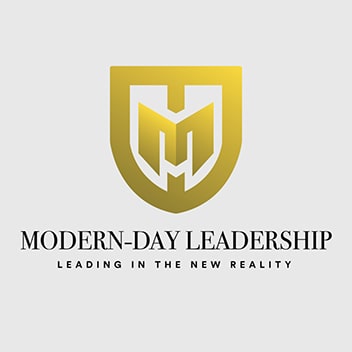
Modern-day leadership program focuses on values-based leadership that deals with the five pillars that every organization leader must acquire to be more effective in their respective spheres of influence.
Contact us to get a free quote on our leadership training program. We tailor the training to the needs and context of your company.
Importance of Leadership
Aside from the apparent reason that leadership plays a vital role in growing the organization, there are more detailed benefits of investing in leadership for yourself.
1. Healthy Work Environment
Leadership can help promote a healthy work environment by creating “psychological safety” in its atmosphere. When people feel safe asking questions, suggesting ideas, and bringing themselves out at work, they get to do better in their jobs.
At most, they would want to engage more in the workplace as they find themselves secure enough to work with their bosses (leaders).
Leadership can positively change how the next generation (Generation Z) of professionals perceive the workplace. Great leaders can retain these young generations and, better yet, help them grow inside the organization.
2. Succession Planning
Transitions and changes happen inside any organization. Whether there is a replacement for new managers or executives or a sudden change in the organizational structure, succession planning must be prepared for the organization's members.
Effective leadership helps prepare members (rank-and-file employees, managers, supervisors, and especially people in the Human Resources department) to take over vacant positions in the company.
3. Low Turnover
With the rise of side hustle (freelancing economy), new job opportunities, work-from-home setup, and low barriers to entrepreneurship, some companies have had a high turnover.
And aside from the reasons above, some employees get frustrated with their working relationships (that they can’t get along with their bosses). This leads to high turnover (the rate at which employees leave the company).
When managers and executives learn effective leadership, they can engage their employees better through effective regular coaching and internal career development plans, leading to less likelihood that their employees will leave the company.
4. Business Results and Performance
Leadership isn’t only inspiring people to become better. It is also guiding them towards getting results in their jobs.
By doing so, you allow them to experience rewards and promotions inside the organization without having to manipulate their minds to do day-to-day work.
When leaders walk the talk, the people under them see exactly the results the leaders perform. Thus, it allows the team members to act on instructions and achieve the results from tasks that they want.
5. Community Impact
Leadership also impacts the community. Bringing positive change to stakeholders and people in society by having leaders change their perspectives is possible.
Community impact, particularly in the government and non-profit sectors, has much to do with how leaders are trained in their respective circles.
6. Work and Life Harmony
Effective leadership is understanding that life isn’t just all about work. That leadership transcends even to personal lives. The best way to test the true leadership of a person is how they behave at home.
How leaders deal with their closest members in the family is a significant determinant of their success in their careers.
Leadership Context in the Philippines
The context of Filipino leadership is quite different from Western principles. Western leadership is leaning towards ” influence,” as Dr. John Maxwell, a famous leadership expert, personally described leadership.
We, as Filipinos, are less likely to be influential and somewhat more empathetic (“malasakit”).
We admire and follow leaders who are empathetic and considerate of other people’s needs and challenges. Influence is defined as being more caring and relational than instructional and delegation in leadership approaches.
Leadership VS Management
Manage things. Lead people.
This is the fundamental difference between the two. While management is focused on improving processes, systems, and tasks, leadership heavily relies on how to make people more effective in the workplace. Its goal is to develop people.
Does a manager need only to be a leader, not a manager?
Not so. Any ranking position must be both a manager and a leader. They must know how to be good at handling people while learning how to be efficient in processes. These two are vital in getting results for their teams and the organization.
How To Be A Good Leader: 28 Essential Skills For Effective Leadership
Leadership takes time. It requires constant improvement to see spots of growth opportunities and become the person people desire to be for other people.
Here are 28 qualities and characteristics of a good leader. See which ones you already have and what qualities you must improve upon.
1. Empathy
This is the most essential trait of any good leader, particularly in the context here in the Philippines, where empathy is perceived to be of the highest value.
Having “malasakit” or “empathy” is even more locally important than being influential. Leaders who have genuine concern over their associates or employees have a high leverage (or influence) on their team members.
You can practice empathy by understanding that personal life affects people’s working behavior. It isn’t easy for Filipinos to ignore personal life issues (or having troubles at home) during working hours.
A good leader who cares deeply for his team members will genuinely ask how they are doing. One good start to developing empathy is asking questions about their life outside work.
2. Resilient
Resilience is bouncing back from failures and setbacks.
Being resilient is one of the critical characteristics of a good leader, especially during the Pandemic (Covid Days) that happened for almost two years. It allows us to see the active leaders who recovered from different challenges.
A resilient leader doesn’t easily give up. They may not know what to do during tough times, but they have a never-give-up attitude that allows them to push through trials and get the win they desire.
This is critically important for teams to have a resilient mindset, especially in the ever-changing marketing needs and demands. Resilient leaders win more and dominate the industry.
3. Adaptable
Adaptability helps leaders think of new ways and strategies to innovate their work. Leaders become more innovative in their work by understanding what’s happening in the market, case of trends, new technologies, and industry updates.
Adaptable leaders allow their teams to be agile and stay ahead of the industry's competition, enabling them to grab opportunities early on.
And through this, they make themselves more powerful and be the top-of-mind teams or brands in the industry.
4. Hospitable
One of the best traits Filipinos have is their hospitality. This became why international people (foreigners) want to do business here in the Philippines because, innately, Filipinos treat their guests with warmth and generosity.
Hospitality allows leaders to build harmony among their team members, strengthen connections, and solidify teamwork.
5. Collaborative
The “Bayanihan spirit” will always be in the hearts of Filipinos. In times of distress, local leaders have a sense of camaraderie, bringing their hearts, minds, and resources to people in need.
Collaboration can lead to better business outcomes, as individual team members can absorb new ideas from their colleagues. No wonder collaborative teams can achieve peak performance at work, resulting in more rewards and promotions within the organization.
6. Humility
Without humility, leaders won’t grow. It is a fundamental trait any leader must possess to sustain success.
It is a challenge for most leaders when they have most of their achievements. There is a tendency to slack off and be complacent at work, thinking they’ve already reached their success.
Humble leaders know that success is only temporary without the desire and hunger for learning. They keep innovating by learning from other people’s suggestions (even from their associates’ ideas).
They understand that wisdom could come from any person, especially from their teams. And from those ideas, they can lead their teams effectively with knowledge and insights.
7. Visionary
Leaders have visions for themselves and their teams. Visionary leaders can propel their teams to the next level of progress, as they know they cannot stay in their current state.
The next level of growth is always yet to come. By having a vision, they would invariably seek to impact more lives through their work. This vision alone drives their purpose and turns into reality.
8. Getting Along With Others
“Pakikisama,” as most Filipinos are familiar with, is a good characteristic most Filipino leaders have.
It is natural for most people to socialize with other people. Having “pakikisama” or camaraderie allows leaders to deepen their connections with their associates. This will enable them to penetrate their people's hearts, increasing the likelihood of success of their working relationships.
It also battles against the number one reason employees leave their companies: not getting along with their bosses.
When leaders know how to connect to their team members, they increase the retention of employees inside the company.
9. Integrity
Integrity is the foundation of any leader. Integrity comes from its origin word, “integer,” meaning “whole.”
The holistic viewpoint of leadership is in the context of home, marriage, work, non-profit, or advocacies. It means that a leader is truly a leader wherever they are. They are the same person at home and work.
This mindset allows leaders, particularly in corporations, to be more aware of their strengths, weaknesses, temptations, and challenges. Looking at their character daily is an excellent start to checking their integrity.
Integrity is “walking the talk” and “talking the walk.” What you speak is what you act, and what you work is what you speak to others.
10. Patience
Patience, in its original sense, is lasting suffering. You suffer from your emotional state, being inconvenient for a long-term purpose.
Patient leaders are considerate of their team members when these people make mistakes at work. They tend to calm themselves, relax, and respond appropriately.
Patience allows leaders to go through challenges without having their emotional downturns affect them. They can manage their emotions properly by being secure and having a healthy mind, soul, and spirit (“emotional intelligence”).
11. Respect For Elders
One of the inherent traits of Filipino leaders is their respect for elders. You see it in their behavior at an early age, “pagmamano,” as a sign of respect.
This is very helpful when trying to lead your people, given you value older generations' wisdom and guidance. You get valuable insights from years and decades of experience of top executives who have honed their expertise in the field and your organization.
Being respectful of elders also means accepting and evaluating their ideas and suggestions. Given they had been through different kinds of work challenges, they knew how to maneuver every significant organizational change. Learning from them helps you avoid mistakes and better prepare for leadership roles.
12. Gratitude
Gratitude opens up new opportunities for leaders. If you’re not grateful, you might miss open doors in your career and personal life.
One of the most significant traits of highly achiever leaders is their gratitude. For Filipinos, we call it “utang na loob” or “debt of gratitude.” Being grateful for what others have done for you allows you to be more humble in your success.
Gratitude helps you be more positive even during challenges and distress. You don’t see yourself as highly acclaimed successful, but you are always open to new improvements to sustain personal growth at work and in private life.
13. Strong Work Ethic
Your commitment to hard work matters. Strong work ethics reveal new opportunities for business and leadership.
People care much about your actions and results, similar to your words. Your actions speak louder than words. Leading by example, which means working harder than your colleagues, portrays a great leadership example for your team members to follow you.
14. Inclusivity
We are living in a multi-generational workforce. Millennials work alongside Gen Zs, so embracing diversity and unifying people regardless of race, religion, and status is a good trait of a Filipino leader.
This is debatable for most leadership thought leaders, as they have different views on inclusivity.
For the most part, leading people with an objective to put them in the right seats and help them perform their best jobs is one benefit of an inclusive mindset.
15. Resourcefulness
As a leader, you’ll be facing different kinds of challenges, including scarcity of resources. Even if you have plenty at the start, you’ll come to a time when there are opportunities that you’ll be looking for help on your hands to do the things that you want.
Essentially, leaders must be resourceful in whatever they have at their disposal. You can’t simply demand everything on your plate, knowing that some things have limitations and boundaries, especially if you’re working on a corporate setup.
16. Faith
Filipino leaders are deeply rooted in Christianity. You can’t ignore this fact if you’re a foreigner wanting to start a business in the Philippines.
You must consider how Filipinos value spirituality to the point that they must file for vacation leaves to attend to their spiritual activities. Being a holistic leader will help you engage more with your employees, as your associates will be more thankful to you once they see you’re taking care of them - particularly in their spiritual area.
17. Charisma
Charisma comes from the word “kharis”, which means “favor” or “grace”.
Interestingly, charismatic people can quickly ask for favors from other people without being manipulative. Given their unique and pleasing personality, they can get more results by freely working with others.
Establish charisma in your sphere of influence by constantly doing small things that build up others. One best way is to say words of encouragement or anything that will build up the confidence and self-esteem of your associates.
Doing so lets your team members be more attracted to you as a leader. And that helps in establishing harmonious relationships with them.
18. Innovative
The ability to think of new creative ideas or formulate new ones from existing processes and methodologies is a good trait of successful leaders.
Given that we’re living in an ever-changing business landscape, knowing how to adapt to these changes by thinking of new ways to improve your current work is one way to thrive during these uncertain times.
19. Accountability
Temptations come for leaders. When they’re not self-aware of their actions and corresponding consequences, they tend to make wrong decisions, which sabotages their credibility.
Taking responsibility for your actions and getting mentors or coaches to whom you’ll be accountable for your leadership is one good way to sustain your success. As we all know, success is a by-product of good character development.
20. Decisiveness
Leaders make dozens of decisions every day. From thinking of what task to delegate to their associates to solving a conflict between their team members, they cause major or minor decisions that can affect the team and its future.
However, it isn’t just about making decisions, but primarily making the right decisions that will positively impact other people’s lives. Being quick, while not being hasty, is a good trait most leaders must embody.
21. Strategic Thinking
Being futuristic allows leaders to plan for the future and stay ahead of the competition. This benefits the teams as they can prepare for any uncertainties (at least for the most part) or be more willing to adapt to changes in their organizations and industries.
Strategic thinkers calculate risks before taking big steps in their career and leadership roles. They gather data, research thoroughly, and see patterns so they can plan for the future.
Being a strategic leader makes your teams more efficient and effective in their jobs.
22. Empowerment
Leaders know how to empower their associates or team members. Autonomy is the new engagement tool in corporate learning today. By letting your team members take charge (in control) and make decisions on their own, you empower them to become the succeeding leaders.
Empowerment of leaders allows associates to see potential in themselves, which helps them build the confidence they need to perform better at work.
The traditional approach to leadership is different. It is leaning on instructing people with specific rules and regulations without allowing them to see their work's direction.
Empowerment differs in that it teaches leaders to create teams who know how to say “no” and “yes” in every decision. This allows for unleashing creativity and innovation among teams.
23. Active Listening
Active listening is one of the highest types of listening. In communication, we teach that active listening helps leaders better understand their colleagues. And from which they can serve their people using their wisdom and tools.
Through active listening, leaders would be better at finding targeted solutions to problems - identifying the root problem of every challenge and not just the surface-level stuff.
24. Inspiration
Inspirational leaders break through the noise. Generally, you find charismatic leaders and well-known leaders to be inspiring.
Through their resources like seminars, books, and other learning materials, you find them someone you can look up to for inspirational advice.
Inspirational leaders bring their teams to the next level. With inspiration, team members can think of new ways to attack their work (“creativity”), strategies, and tools to get results for themselves and the organization.
25. Authenticity
You can’t fake it til you make it to success. Success requires authenticity to gain the trust of clients, stakeholders, and colleagues.
Without authenticity, you’ll be alone in tasks as other people don’t want to associate with you.
Authenticity attracts great people to your team, which is essential when hiring people for your organization. When you talk with sincerity, people can feel it and want to listen and learn more from you.
26. Problem-Solving
Problem-solving has become more difficult nowadays, especially for leaders with dozens of employees underneath them. With hundreds of challenges they face every month, having a problem-solving mindset helps them find solutions quickly and creates an atmosphere where team members can share their experiences, including their mistakes and challenges.
Having this kind of culture in the workplace makes it easy for leaders to cope with the demands and stress of work. When an empowered leader can strengthen himself in solving problems, their associates will follow in their footsteps.
27. Stewardship
Stewardship is using your resources to the fullest potential with your God-given abilities. Every one of us is capable of turning nothing into something. Putting our resourcefulness into action is only a matter of faith and dedication.
When a leader has a sense of stewardship, he allows himself to be accountable for his actions while on the results of his team members. He would do his very best to seek the welfare and well-being of his team more than his own.
Stewardship now results in a selfless attitude for leaders to take care of their teams and allow them to be nurtured by their coaching skills.
28. Continuous Learning
You’re here because you probably have this trait - continuous learning. You won’t be reading until this part if you don’t keep yourself learning new things.
The very essence of leadership is to improve oneself so you can share what you have with the people you’re leading.
Continuous learning allows leaders to gain new insights and wisdom from other people’s experiences, learning materials, and their own evaluated experiences. This expands their capacity and drives more abilities to be more productive and live a significant life.
Leadership Trends in 2023 and Beyond
The business landscape is changing, and so must leadership. Adapting to the latest trends and best practices in leadership allows us to be more effective in our field of endeavor.
Quick note: I’ll constantly update this post to add new leadership trends I’ll notice and learn from other leadership resources. So, expect some new learnings in this section.
1. Coaching
Coaching is mainstream in organizational development and employee engagement. It positively affects how employees perceive leaders and how managers and supervisors can better enhance their leadership skills.
You’ll find one out of five companies today in the Philippines that are looking for various coaching training programs, whether they want to train their managers on how to coach people or get a Certified Gallup Strengths Coach to help their teams identify their strengths and use it as an advantage for team performance.
Read more: Gallup’s Comprehensive List of Leadership Coaching Articles.
2. Flattened Org Structure (No “Silos”)
With the rise of tech startups in different countries today, including the Philippines, a massive change has occurred in how CEOs and startup entrepreneurs devise their organizational structures.
For the most part, and in the traditional sense, you’ll see organizational structure to look like a tree. From the top, we have the C-Suite, then Directors to Managers, down to rank-and-file employees. Different department heads categorize all.
Today, you would see a flattened organizational structure where the CEO isn’t only operating as the top head of the organization but can also work directly with the Operations Department. He could go up, down, and even lateral in the organizational structure to function coherently among the teams.
This structure allows for faster and better communication, where ideas flow smoothly from top to bottom. And as rapid changes are happening in the business landscape, this is more advantageous for startups to innovate and even disrupt themselves so they can better serve the needs of their customers.
Further reading: The Silos Mentality: How to Break Down Barriers
3. Coopetition
Coopetition is a coined term from two words, “competition” and “collaboration”.
Coopetion means that individuals in teams can compete among themselves and highly regard one another for collaboration.
Promotions and rewards are given appropriately based on individual performance but could now be done in teams. This kind of thinking allows leaders to engage their associates better, as these people may be working towards achieving excellent results for the company while also being rewarded individually for their hard work.
Leadership Resources To Help You Unleash Your Leadership Potential
Leadership development is a continuous journey; one must constantly learn from new materials available in the market and be more adaptive to every change happening in the business landscape.
Let me give you my list of recommended leadership resources. Some are old but contain timeless leadership principles. Others may not be familiar with the authors/s, but I believe they have impacted my life.
Bible
The Bible contains leadership lessons anyone can apply to their career, business, and personal lives.
For most people, the Bible is only used for spirituality. Still, applying leadership in my roles as a spouse, entrepreneur, and active non-profit volunteer is very practical.
Here are some of the Bible verses you’ll find to be applicable in different organizational leadership settings:
Psalm 78:72
With an upright heart, he shepherded and guided them with his skillful hand.
Matthew 20:26–28
It shall not be so among you. But whoever would be great among you must be your servant, and whoever would be first among you must be your slave, even as the Son of Man came not to be served but to serve and to give his life as a ransom for many.
Luke 12:48
Everyone to whom much was given of him will be required, and from him to whom they entrusted much, they will demand more.
Further Reading:
Dr. John Maxwell Leadership Books
Considered the world’s leadership expert, Dr. John Maxwell has written over a hundred leadership books.
His leadership books are classic, practical, timeliness, and contextually applicable to many facets of life and dimensions.


Here are some books I’ve read with great insights on personal growth and leadership.
21 Irrefutable Laws of Leadership
It is one of Maxwell's best-selling books and has covered the fundamental laws of leadership. Apply some quickly, and you’ll see instant career, business, and personal results.
One law I’ve used and trained thousands of leaders is the “Law of Lid,” which states that leadership ability is the lid that determines the leader’s effectiveness.
If your lid is “8”, you can only lead others with a leadership level of “6” but never “10”. But if you’re on level 10, you can lead level-8 people.
As simple as it sounds, it is very profound when you apply to your leadership roles.
This isn’t a leadership book, but is highly valuable for any leader. Laws of Growth book gives you ways, strategies, and tools to jumpstart your personal leadership journey.
The first law is “intentionality”. If you want to experience 10x growth in your career and personal life, you’ve got to be “intentional.”
Intentionality plays a vital role in displaying the right attitude and habits. Great intentions will always be reflected in actions.
James Kouzes and Barry Posner
These two leadership experts may not be famous in the Philippines, but bear with me; they’re renowned experts in the global leadership scene.
Their “The Leadership Challenge: How to Make Extraordinary Things Happen in Organizations” has been updated several times to adapt to today's business market.
As I read, this book is like reading a textbook filled with facts and knowledge. You wouldn’t end the book without building your leadership foundation on facing challenges we all experience as leaders.
I would say this isn’t for the newbie readers, but if you’re looking for a little advanced type of learning, Kouzes and Posner’s learning materials are great reads.
Craig Groeschel
Most leaders here in the Philippines are spiritual leaders of churches. And in the Christian world, Craig Groeschel, a leading pastor of Life Church, teaches how leaders can be successful in their spheres of influence.
Though the author speaks mainly from his experience as a pastor, you would find all his leadership materials, including his podcast, to be highly valuable in a business context.
His teachings are timeless. You can repeat it again and again to further extract the gold insights from it.
Resources from Craig Groeschel:
Andy Stanley
Andy Stanley is a renowned church leader but is also very active in speaking for hundreds of leadership conferences and conventions worldwide. You will notice he is a great communicator in how he delivers his speeches.
Profound and full of wisdom, Andy Stanley can be part of your leadership mentor (online).

Resources from Andy Stanley:
Local Leadership Thought Leaders
Venchito Tampon
Venchito Tampon has been in the corporate and public speaking industry for almost 9 years. He is a serial entrepreneur with 4 companies, including SharpRocket, a digital marketing company specializing in SEO services—Blend N Sips, coffee eCommerce, Hills & Valleys Cafe, and Rainmaker - a consultancy brand.
Francis Kong
Francis Kong has been teaching leadership lessons for more than four decades. A pillar in the local leadership scene, you’ll find Mr. Francis Kong inspiring with his daily Facebook quotes/posts.
Francis Kong is an active columnist in the Philippine Star, a director of Inspire Leadership and Success Options, and has been an active independent board of directors for some of the biggest companies in the Philippines.
Al Ian Barcelona
Al Ian Barcelona is one of the underrated leadership experts in the country. I became his mentee for over a year, and he has been helping me immensely with my leadership roles as an entrepreneurial and non-profit social leader.
You won’t find him very active on his social media profiles, but he’s famous in most corporate training circles, conventions, and seminars.
He is efficient, knowledgeable, and witty in his leadership training programs, primarily with government agencies and corporate organizations.
How to Be A Passionate Leader: 10 Proven Tips to Ignite Your Influence
A passionate leader can inspire their teams and transform how they perceive their work and personal lives.
Through passion, leaders can bring something exciting to their leadership endeavors and ignite their influence over their associates.
In this guide, I’ll show you 10 proven tips on how to be a passionate leader.
Let’s get started.
How to Be A Passionate Leader: 10 Proven Tips to Ignite Your Influence
1. Have A Compelling Vision
Vision helps you progress in life. Without vision, you go with the flow in life or imitate other people’s way of living.
Compelling vision unleashes your potential as you start seeing the future at the present moment. It gives you hope and excitement to move forward despite many challenges and troubles in leadership.
A passionate leader always has a vision for himself or himself and for the team they are leading.
Communicate your vision to your team, as it can bring both passion and inspiration to them. It serves as a lightbulb and awakening for individuals who don’t take initiative. At the same time, it gives more empowerment to high-performing individuals.
Vision fires up more passion for a leader. Consider investing in leadership training for your managers and supervisors so they can craft a compelling vision script for themselves.
2. Know Your True Identity
Identity is who you are as a person. It is where your actions and words come from. The way you see yourself affects your passion and purpose. When a leader knows who they are, it is easier for them to be passionate in their profession.
Identity helps build confidence that doesn’t dismiss other people’s feelings—but is founded on humility to serve more people through value-adding works.
Knowing your true identity by digging deeper through self-awareness helps you see better things in others. It reflects how you treat others and become passionate about helping them.
3. Be Driven By A Purpose
Your purpose sustains your passion. As leaders, you’ll be facing different kinds of trials. Moments of disappointments and setbacks will kick in that would want you to give up and quit.
During these times, you actively need to go back to your purpose. By seeking again your “why”, you’ll be reminded of the people and things that matter to you - that will give you the reason to start your leadership journey.
Your purpose could be to inspire others to live a better life or as simple as changing how people perceive themselves at work.
Whether societal, cultural, or personal, passionate leaders are ultimately purpose-driven. They know their why, and that’s enough to move them into changing other people’s lives through their leadership roles.
4. Never Stop Learning
Passion dies when there is no growth. Learning new things is the key to igniting your fire at work and in leadership roles.
Life is full of lessons we can learn from our own experiences and the lives of others. By being absorbent and observant of how successful leaders live and lead their lives - you can avoid mistakes and skyrocket your leadership career.
Being a lifelong learner offers many benefits to passionate leaders. Leaders can assess themselves and identify more of their strengths and weaknesses. The key is to maximize and leverage their strengths to communicate effectively to their teams and coach and mentor their associates to higher productivity.
All while being aware and doing the necessary things to minimize their weaknesses and turn them into strengths.
There are several learning ways, including ebooks, webinars, workshops, seminars, and online courses. All these you can consume at home and at the convenience of your time.
The only thing that will hinder most leaders who want to learn is their attitude and mindset.
So, grow from a fixed mindset to a growth mindset and start learning to develop yourself and your teams.
5. Seek A Community To Guide You
Your passion today might change tomorrow. New interests will replace your interests. So, it’s essential to be surrounded by a community to help fuel the leadership passion that is in you.
Leaders face challenges, undoubtedly. But a community or a support group whose goal is to develop themselves for the better can help bounce back from adversities and live a new version of you every day.
Learn from mentors and coaches around you. Seek their advice and never stop becoming a sponge - acquiring wisdom from them.
Do not simply get knowledge - there’s vast information available online. Instead, seek wisdom from trusted people. They can give you the proper application of knowledge in the context you’re in right now.
Passionate leaders seek a community because they know a healthy environment will fuel their passion even more.
6. Build Habits That Stick
Success is simply an accumulation of the proper habits and discipline.
The same goes for leadership. If you want to become a passionate leader, you must build the right kinds of habits. Habits that will sustain your success and will thrive amidst all crises and challenges.
Some habits you should include in your daily life are:
- Reading books and learning new information
- Communicating effectively with your team
- Casting vision
- Coaching and mentoring your people
- Setting a 1-on-1 discussion with each of your associates
These habits will help you reach your tipping point, where all accumulative results will lead to big wins at work and in your personal life.
Habits require relentless discipline. Producing output every day as an excellent leader isn’t an easy thing. Sometimes, there isn’t enough motivation to do great work. And that’s where discipline comes in.
Discipline is doing things even if you don’t have the motivation to do so.
7. Consider Rest As Part Of Work
Passion comes from its root word, “passio”, which means “suffering”.
You will genuinely consider if a leader is passionate if they go through suffering and still have hope and love for work.
Some people tend to burn out while pursuing great things during these times when they need to consider rest.
Rest is part of work. You take breaks from working hours to rest your physical body and mind, which will help you think and reflect upon your leadership roles.
A leader is more productive when they are rested. So take some time to relax by using your holiday leaves and vacation season to spend time with your family.
The more you are rested, the more you can unleash your leadership potential.
8. Share Your Vision
Vision casting is a powerful way to lead your team with direction. Sharing and communicating your vision lets your team members glimpse the organization's future and their team.
Based on your vision and what you think is relevant to your business, you would have a compelling vision to share with your team. Being a delegative leader requires having the vision to share with others.
If you see passion dissipate, invest time in a whole day or half-day session to return to your vision. Communicate why it is helpful for them and the entire team. This way, you will ignite their passion again to contribute and perform better.
9. Engage With Co-Leaders
Community can help you regain confidence and bring back the passion that once was lost. Especially if you surround yourself with leaders, coaches, and mentors who are more experienced than you and could inspire you the moment you have conversations with them.
Engage with colleagues with leadership roles and more significant influence than you. You’ll acquire some insights and lessons you haven’t considered before, which could positively impact your personal and career life.
10. Empower Your Teams
Passion is contagious. If you serve others, your people will also serve you.
If you empower them, chances are you will be empowered. That’s why one Scripture in the Bible says that those who refresh others are also refreshed.
Empowering teams can ignite your passion as a leader.
There will come a time when your associates will be your source of strength and inspiration. And in those situations where you need encouragement, it is vital to keep going and perform better in your leadership roles.
Consistently empower your team. Raise them and appreciate their excellent work.
Fuel Your Passion Every Day
The key to being a passionate leader is learning to balance productivity and rest so you can step back, reflect, and learn from your experiences. All while pursuing your goals and purpose in life, doing it daily, and achieving momentum and progress in your leadership roles.
How to Market Corporate Training Programs
One of the significant challenges of freelance L&D practitioners and corporate trainers is learning how to market corporate training programs.
No matter how effective these programs are in changing other people’s lives, you will find missed opportunities if no one provides the training service.
In this guide, I’ll show you five core pillars that are more than just the “publish content and leads will come” mentality.
1. Invest in Networking
This is obvious, but most L&D and training professionals use this to initiate hard selling with others during networking events.
Start by building relationships and offering value as much as possible without expecting anything in return.
Instead of instantly hard-selling your training services without value in return. Essentially, you want others to replicate your value by asking you to join their in-house events and train their employees.
In the Philippines, PTSD offers public events where the best trainers and L&D practitioners gather to attend, listen, and learn from top-caliber speakers. This is also a way for networking and learning from others in the community.
Networking is like planting seeds and reaping the rewards for months, years, or even decades.

It is one of the underutilized tools in marketing corporate training programs.
If done effectively and ethically, it could result in multiple buy-in to your training programs (without actively selling services in events itself).
2. Build An Online Personal Brand
Personal branding is more profound than just posting social updates of influencers.
For the learning and development industry, personal branding is more of an educational, providing valuable information that addresses the particular needs of your target audiences.
Consider giving previews of your talks and training sessions, where a 2-minute video discussing a single topic intently could help potential clients (internal HR teams) see the value of your content and how you deliver it to your participants.
Identify topics that address your audience's challenges, pain points, and problems.
For example, if you’re targeting employees, you can repurpose your talks on workplace ethics and excellence. Or, if you’re speaking about leadership and management for C-Suite and senior leaders, you can repurpose your videos on Five Levels of Leadership.
Hire a copywriter or do the caption writing yourself to contextualize every content you publish.
The key here is repurposing your existing resources while not overspending time marketing your training programs. All the while giving value through your repurposed videos and written content assets.
Consider recordings of training sessions as content assets. Aside from repurposing it, you can utilize it as a portfolio whenever potential clients ask for work samples.
Repurpose video or audio assets into written blog posts to maximize their value and get organic traffic via ranking for target keywords using search engine optimization (SEO).
Utilize social media platforms to its fullest to increase personal brand reach.
Organic marketing is free and can help you build a strong brand for your training company by consistently posting social media content.
This requires a full-week content plan in your social media calendar. You can invest one to three hours a week to create and schedule across different social media platforms - Facebook, Instagram, TikTok, and Linkedin.
3. Create Your Website and Use SEO To Get Organic Leads
Most training companies, L&D practitioners, and consultants use websites as calling cards - underutilizing their impact to drive potential clients to your business.
Search Engine Optimization (SEO) ranks websites in Google’s SERPs for specific commercial and informational keywords that the target audience is searching for.
By ranking for the most important keywords your training or consulting business wants to dominate in the market, you’ll have an immense advantage over other competitors who don’t have the resources and team to utilize SEO as a marketing channel.
Let’s use this corporate training blog as an example.
Our training company, Rainmakers, currently ranks number 1 for the target keyword, “corporate training Philippines”.
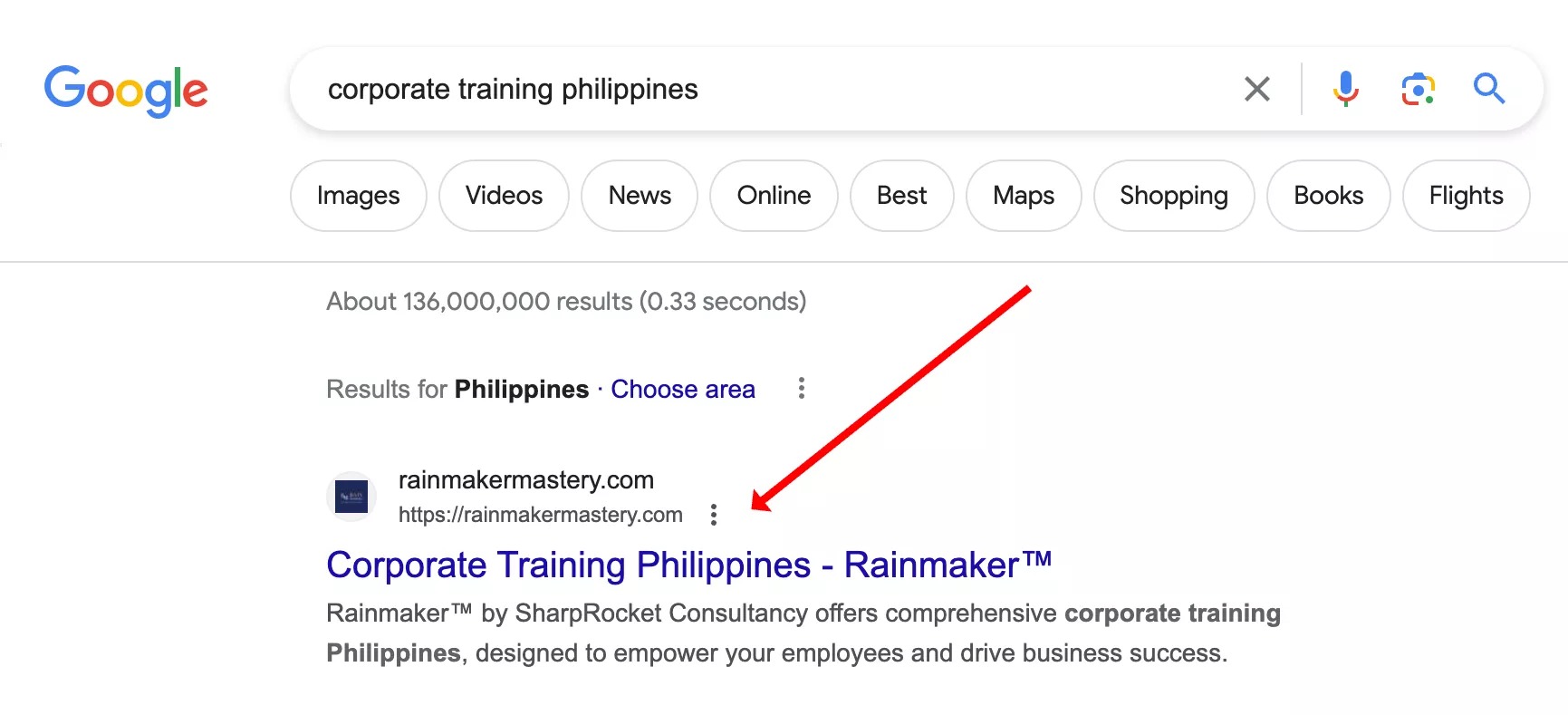
It drives tens of organic leads from clients doing Google searches for the term or its relevant keywords.
We also rank for other corporate program-specific keywords like “personality development training Philippines” and “cross-cultural communication training” .
Create dedicated landing pages for each keyword.
So, if you target clients within a specific country, region, or local area, you can include it alongside your target keyword (e.g., corporate training services in Brisbane).
Then, include the keyword in your page's most essential optimization places, including meta title, URL, first sentence, H1, H2, and image alt tags. This would signal to Google and other search engines what you are referencing - given the keyword of your choice.
This approach enables my corporate training company to dominate most of the keywords related to corporate training in just 8 months.
You can use SEO tools like Ahrefs or SEMRush or look at the autosuggest completion feature of Google to find specific corporate training programs people are looking for in your target country or local area.
This helps you identify the most searched keywords, optimizing your pages accordingly.
4. Deliver The Highest Value In Corporate Training
This element won’t be categorized as just “purely marketing”, but as an essential part of delivering the best client service to corporate clients, which can lead to multiple referrals and positive word-of-mouth about your brand.

Aim to excel in all phases of the corporate training process, from training needs analysis to training delivery up to the evaluation part.
The perceived value in corporate training programs includes the quality of transference of learning from the trainers and facilitators to participants and its post-training impact on the dedicated team or organization (based on levels of evaluation).
If you do great work, you’ll obviously acquire repeat training schedules from highly satisfied clients.
5. Joint Venture With Other Training and Consulting Companies
Building and strengthening relationships with like-minded, even competing companies enables both parties to acquire new clients in a mutually beneficial manner.
Not only do they offer similar services, but each of the training companies has strengths that others can complement.
Partnering with other training companies to transfer any inquiries for which your team doesn’t have in-depth expertise is imperative. At the same time, they can share new businesses with your team that has experience delivering training.
At Rainmakers, we partner with AIB Training and MSS Biz Solutions for specific corporate training programs, including team building, customer service, sales accounts management, and English fluency.
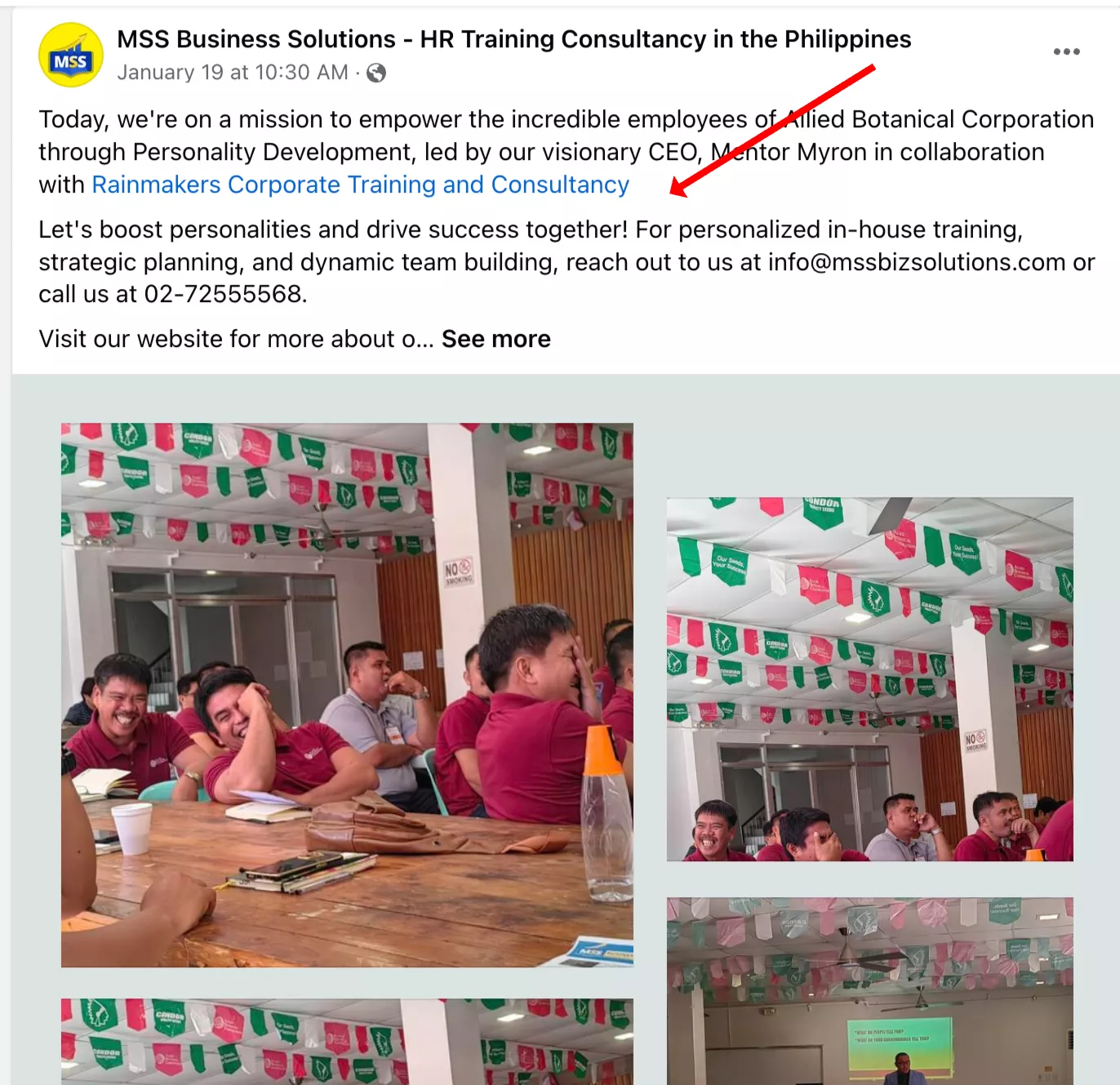
This approach enables us to focus on what we’re experts in and craft better transformative corporate training programs for our clients.
Marketing is Building Your Brand
Learning how to market corporate training programs is more than checking off “to-do list tasks” of posting social media content. It has a deep core focal point to build a brand that will last, and clients in the learning and development industry will recognize it as valuable to the industry.
Leadership Excellence: 5 Steps To Develop a Healthy Culture
Leadership excellence plays a significant role in developing a healthy culture in the organization. Becoming an effective leader impacts business results and a solid foundation to sustain the organization.
In this article, I’ll walk you through the different topics on leadership excellence and how you can use it to create a healthy culture in your company.
What is Leadership Excellence?
Leadership excellence is the ability of a leader to develop his associates and create a healthy atmosphere where there is psychological safety, empowerment, and support.
Difference Between Ordinary Leadership and Leadership Excellence
Mediocrity won’t make it cut to success, which most starting managers and supervisors start their leadership career.
Ordinary leadership happens when you’re leading people based on authority and position. According to Dr. John Maxwell’s Five Levels of Leadership, ordinary leadership is similar to 1st level of leadership: leadership based on rank.
At this level, people follow leaders because “they have to.” It is part of their job, or requirement, to follow you as these people are promoted in the company. They achieve their leadership role because of their technical skills.
Conversely, leadership excellence includes having outstanding leadership qualities that allow the leaders to influence their people and make positive changes in their work and personal lives, so much so that they create a leadership distinction in the organization.
Executives, directors, and top managers suddenly recognize these excellent leaders for their service work and the value they consistently provide to their teams.
Benefits of Leadership Excellence To The Organization
Leadership excellence has a direct correlation with organizational success. The stronger and better leaders are, the higher the organization's likelihood of success.
It is as simple as this: the people working for the organization are the main reasons the entity exists. So, if leaders effectively lead teams, you can see great and sustainable business results and success.
Here are more compelling importance of leadership excellence to any organization.
1. Builds trust.
Trust is the glue that binds people in the organization. When there is trust, it is easy for employees to work, as there is high regard for well-being and psychological safety.
Now, people go to the office with joy and enthusiasm. In one recent survey by Gallup, 22% of the employees trust their leadership, which has helped them increase employee engagement and business results.
If people trust their leaders, they can easily suggest ideas and room for improvement to benefit their work, teams, and the entire organization.
Stephen Covey, author of 7 Habits of Highly Effective People, once said, “Without trust, we don’t truly collaborate. We merely coordinate or, at best, cooperate. It is trust that transforms a group of people into a team.”
2. Improves business performance.
Leadership excellence isn’t hype. One of the benefits of effective leaders is their ability to drive results for themselves and their teams. In other words, they care as much about business performance as they care about their people.
There is a direct correlation between leadership excellence and organizational success.
Effective leadership enables vision to guide people into achieving their key performance indicators,
3. Creates a healthy work environment.
Excellent leaders help create a healthy work environment where people feel safe to suggest ideas and give feedback to their colleagues.
Most younger generations are looking for this environment - they want something they can learn from and better themselves.
Excellent leadership removes hierarchical issues, allowing top-down feedback among team members. This fosters internal growth and innovation, as employees can think of new ideas to adapt to the ever-changing needs of the market and business landscape.
4. Improves decision-making and problem-solving capabilities.
Putting up great leaders with solid ethics, skills, and attitudes can help your team improve their decision-making.
Autonomy is a vital factor in succeeding in any industry. When employees feel and know they can make decisions independently and have control over the task they’re into, they’re likely to solve challenging problems and provide excellent solutions for them.
Effective leadership helps unleash the capabilities of team members, giving them specific growth opportunities. One organization can experience a healthy work culture through autonomy and control, where everyone is creative enough to produce results.
5. Boosts organizational reputation and stakeholder trust.
As mentioned earlier, trust-building glues everyone on the team. Now, that translates internally and from outside people interested in the organization, including stakeholders, customers/clients, and potential investors.
There is also word-of-mouth, resulting in good public relations for the company when people inside are working harmoniously, not dragging everyone down. Instead, it helps everyone to achieve their individual goals and guides them to achieve work-life harmony for their personal lives.
All these will help boost the organization's reputation and gain stakeholder trust.
6. Attracts and retains top talent.
Excellent leaders help attract talents, as internal employees become the go-to source of recruits from the outside. Given that they share their work experiences with friends, past colleagues, and networks, hiring great talents is now easier for the human resource department.
As we all know, great employees attract good company. That is very much applicable in retaining staff as well.
Leadership Excellence: 5 Steps To Develop a Healthy Culture
1. Think win-win-win.
The most extraordinary executives and directors who have made a massive impact on their community, even on a global scale, are the ones who have this triple-win philosophy.
Win-win-win philosophy: Win for the company, win for employees, and win for clients/customers.
It is a triple win for these three groups of people.
Excellent leadership is understanding that you can’t do great things alone. You need support from your employees and to earn the trust of your customers/clients.
And you can only make a considerable impact knowing that trust is built from these people. Earning it would take time, even years, to do so, but it will be worth it as you can experience a breakthrough when this triple-win philosophy becomes a reality.
2. Communicate the vision.
Vision isn’t just a statement you post on office walls. Vision must be communicated across teams.
The most outstanding leaders worldwide are the ones who can cascade their vision from top to bottom—knowing that this vision will make a difference in how top managers and employees will perceive their work as something that contributes to the bigger goal of the organization.
Vision must also be communicated by leaders regularly. Whether during town halls or one-on-one discussions with his key leaders, they should share the vision through a subtle conversation approach.
And when acted upon, vision becomes a reality when people see it happening in the lives of their leaders.
No one would believe vision is achievable unless the leader himself believes so.
3. Navigate change.
Changes are inevitable. Either you change, or you let the world change you.
In any industry, especially highly volatile industries, you would find changes in the market and niches daily.
With artificial intelligence (AI) advancements and technological innovations, people crammed every tool to help automate their routine work.
But what separates great leaders from the average ones is their ability to manage change.
Change management is a practical skill for top-ranked leaders that, if they can master it, can make a big difference in how well they can lead their people and achieve business results.
It requires emotional intelligence, problem-solving skills, communication skills, and various hard and soft skills that, in the aggregate, can help develop the leader's character.
4. Promote holistic excellence.
We live in a generation where professionals aren’t just working solely for money. They are now working with purpose and with a solid inspiration they bring to the workplace.
In other words, if you are leading to push people to get results for the organization, it only takes some time before your people leave you.
Effective leaders promote holistic excellence. They demand it for themselves and teach and train the principles to their teams.
Holistic excellence includes reaching new heights in human beings' career, personal, health, and social aspects.
By tapping into the holistic approach of leading people, you increase employee engagement and achieve work-life harmony. Now, this translates to lesser burnout in your team players and increased joy and happiness working in your organization.
5. Develop a second line of leaders.
Success planning is essential in any organization. When leaders know they need to develop new leaders constantly, they have an immense advantage over their competitors when someone (or a group of people) leaves the company.
They have someone prepared for the position they can replace for any vacant job at any given time.
Leadership excellence is developing second-line leaders through effective leadership training in the Philippines. It is understanding that things change, even the motivation of people change, so they have plenty of options whether to stay or leave the company.
And being ready for that is a leadership advantage.
Key Takeaways
Develop the kind of leaders you want to achieve, the type of organization that lasts for years. Leadership excellence brings tremendous results for those who know how to do it right for their people. Through coaching and relationship building, anyone can become a great leaders as long as they desire and take action to grow within the organization.



